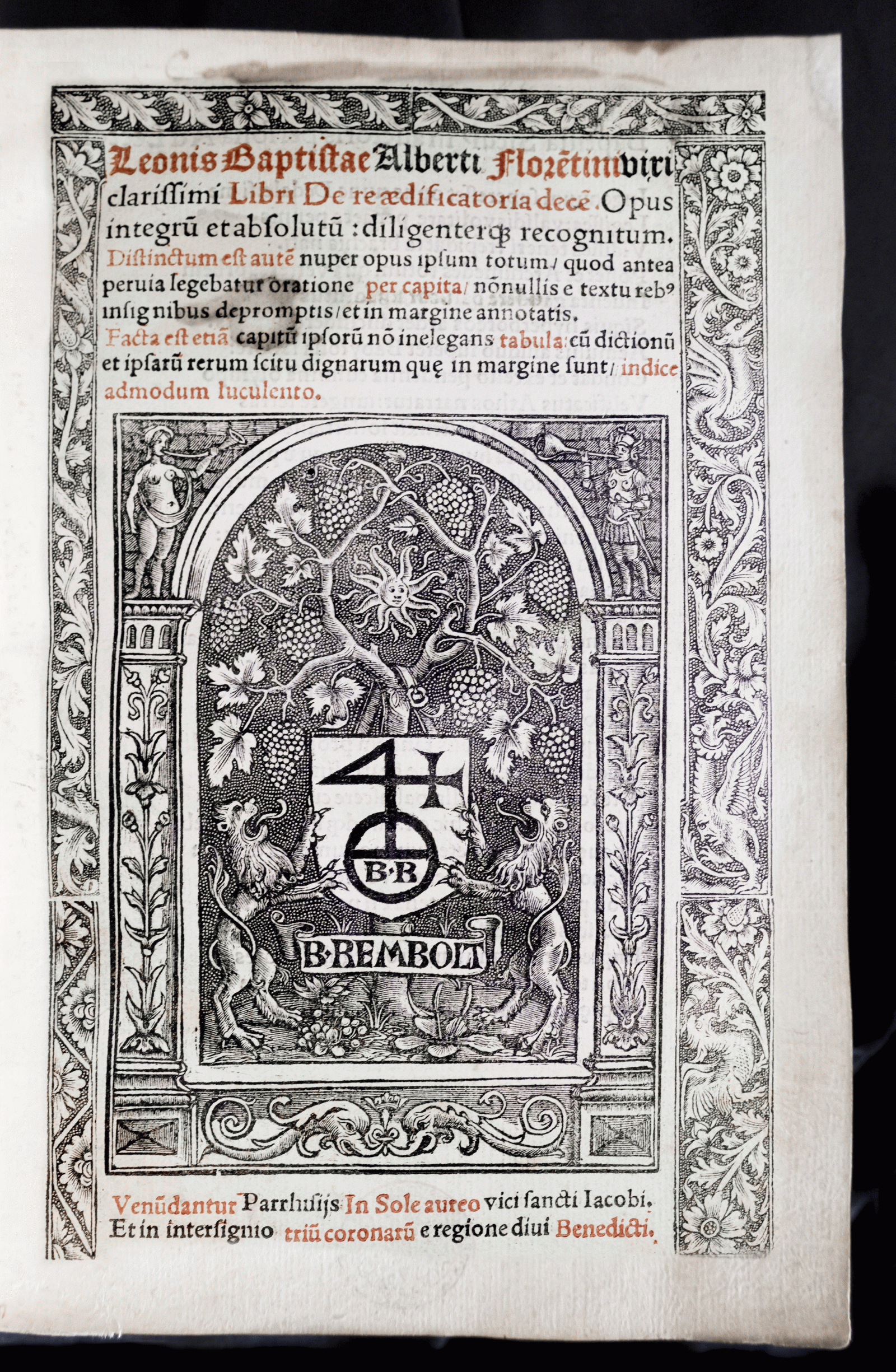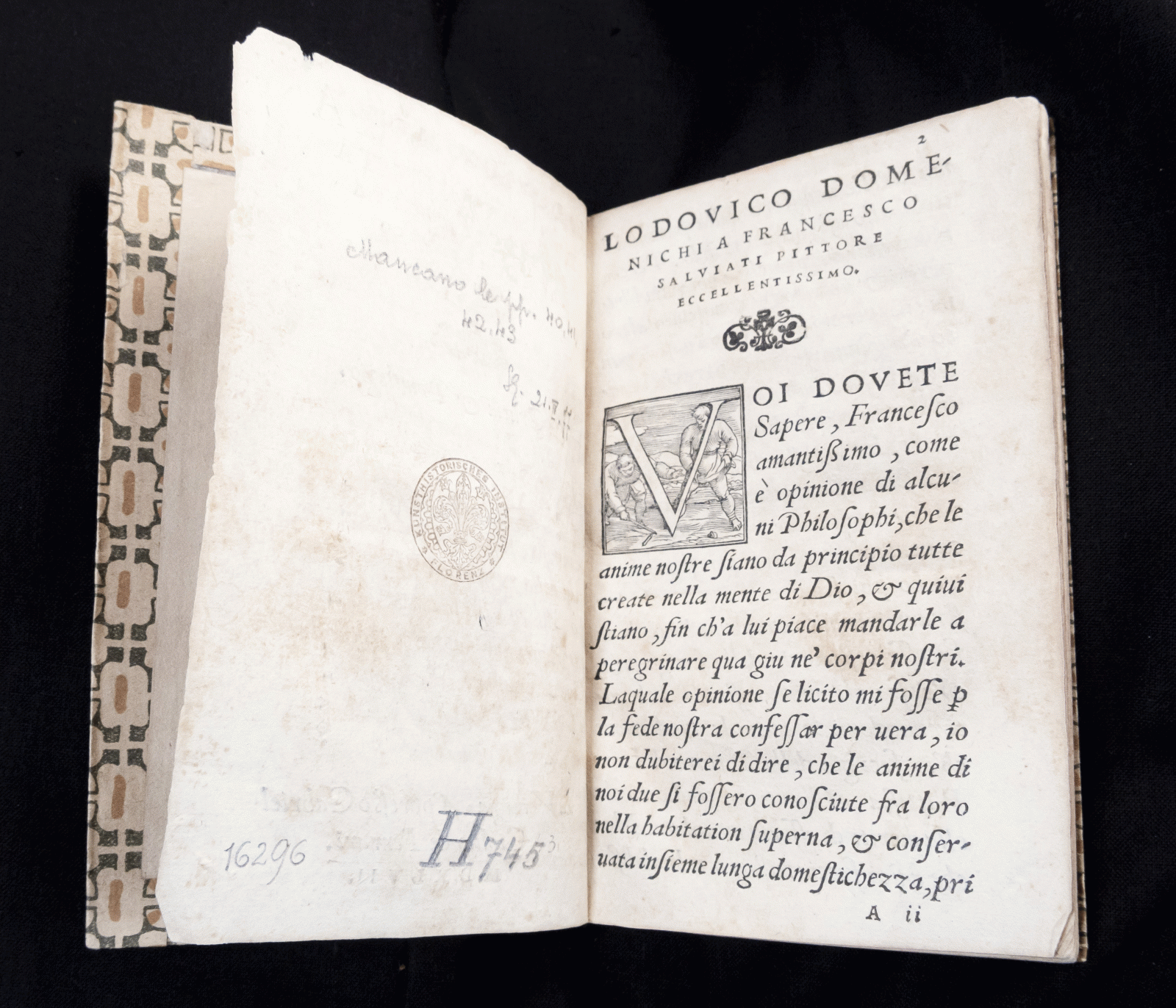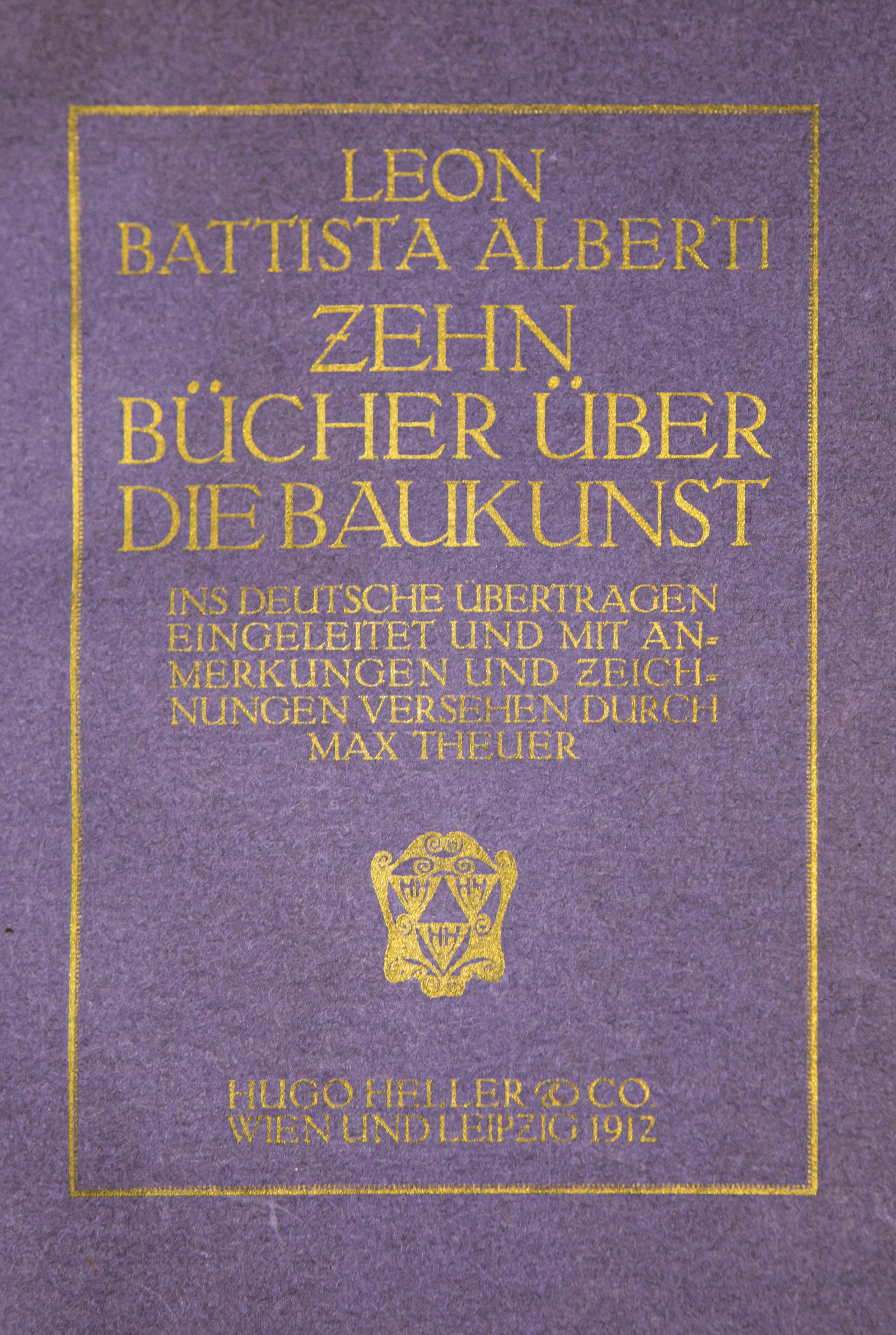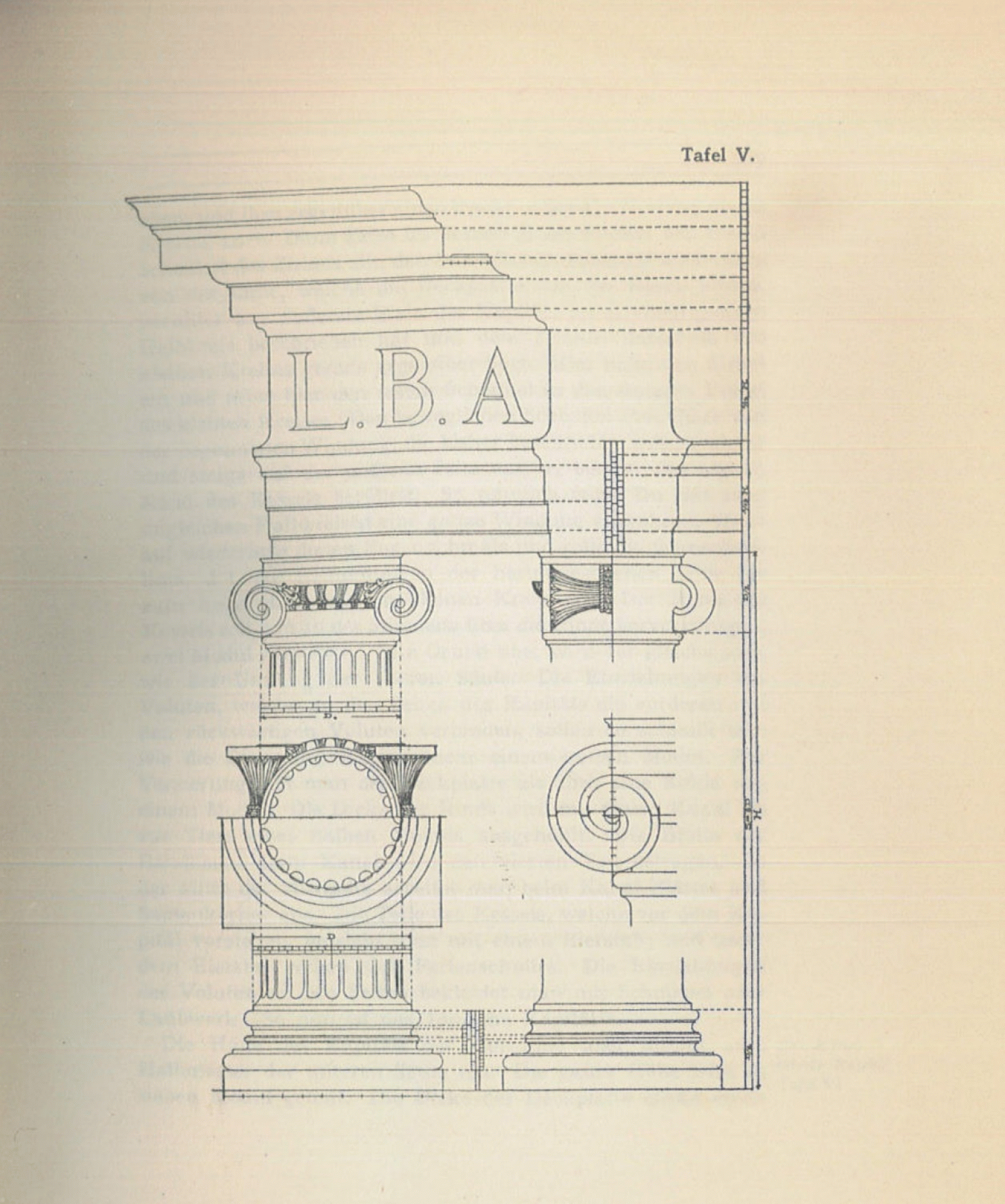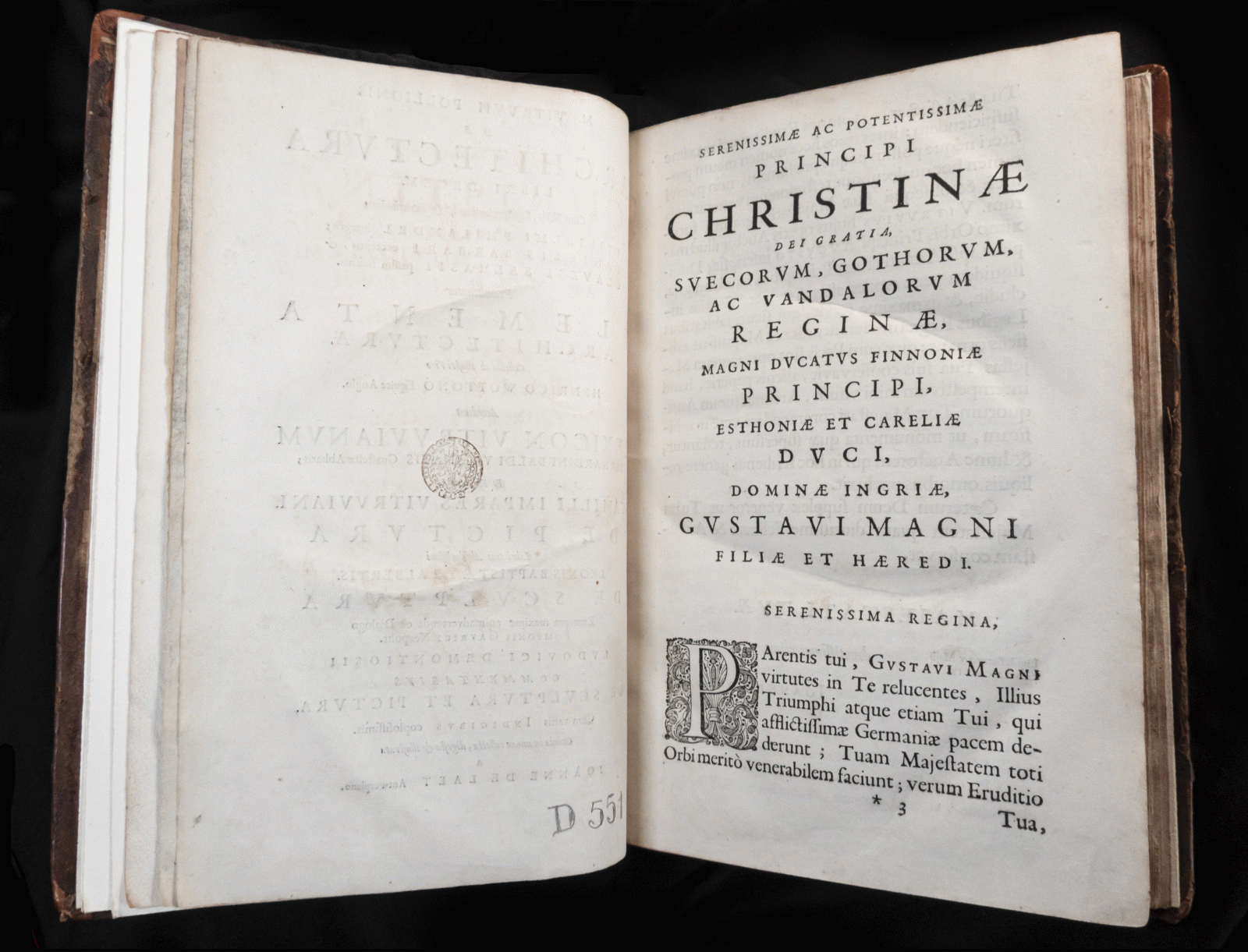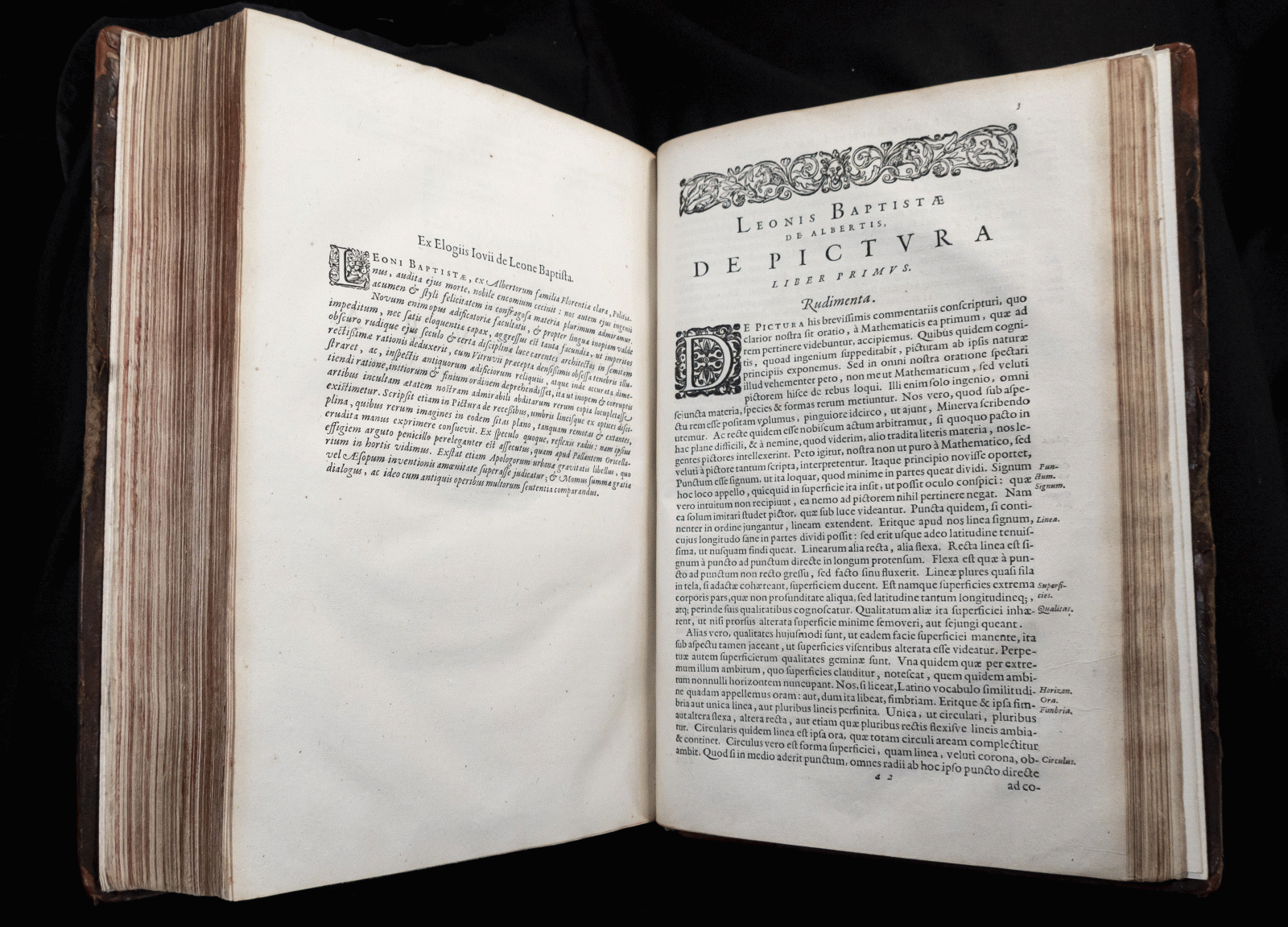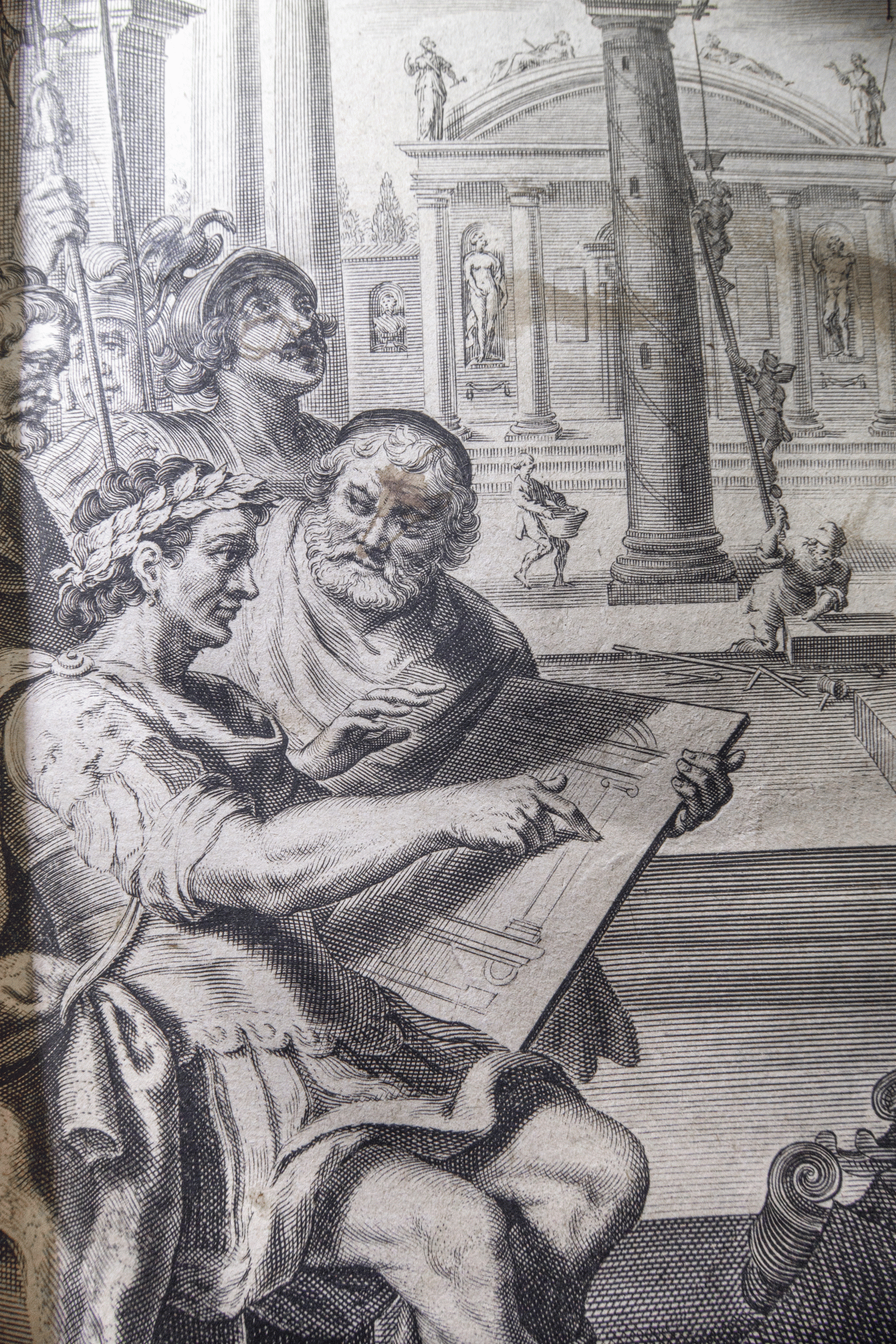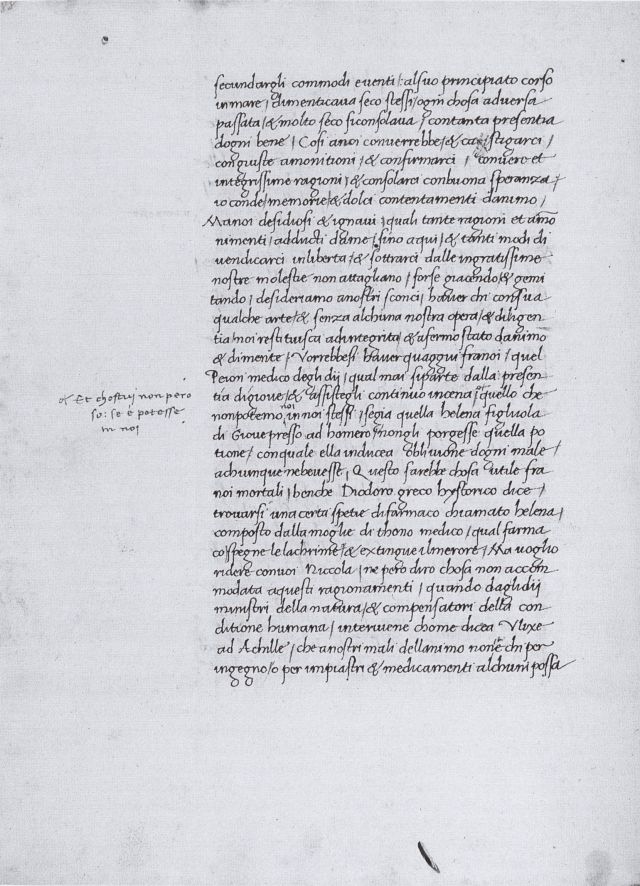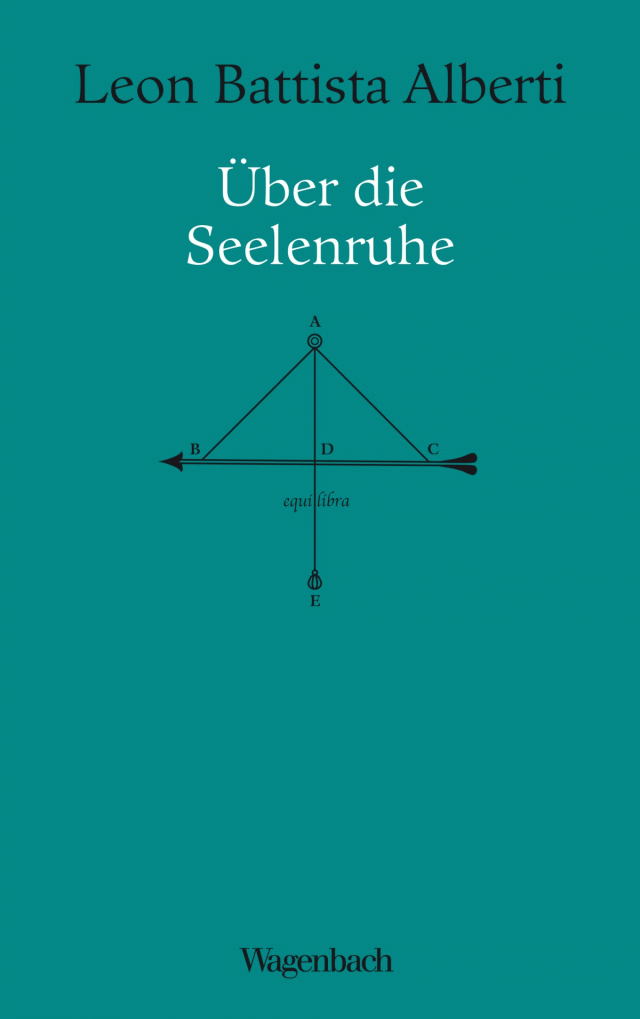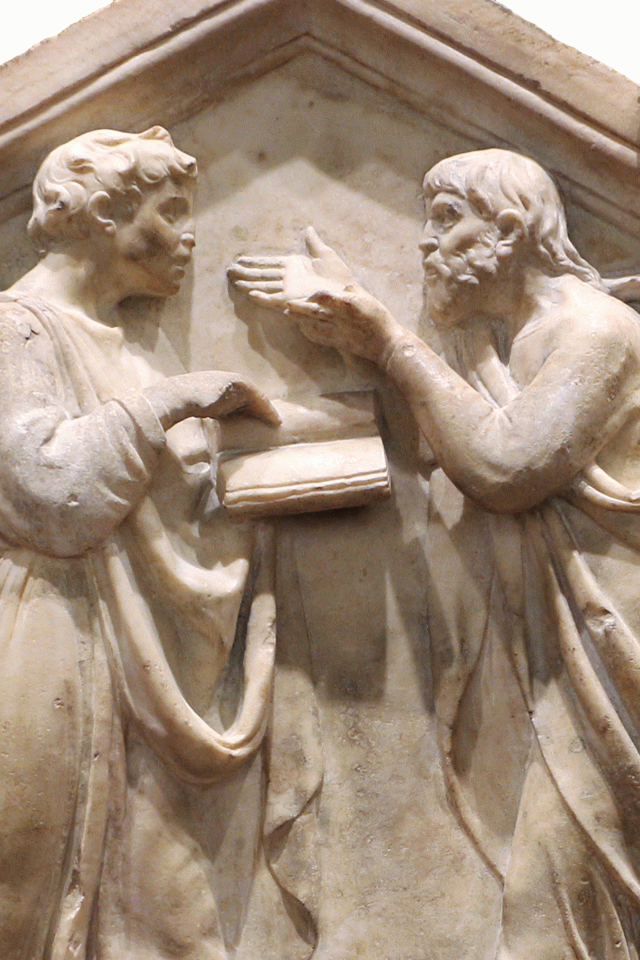In Focus
Figurations of Space.
Alberti Prints in the Rare Books Section of the Library
Marking the 550th anniversary of the death of Leon Battista Alberti (1404–1472) and the publication of the first German edition of his writing Della tranquillità dell’animo (On the Tranquility of the Soul)
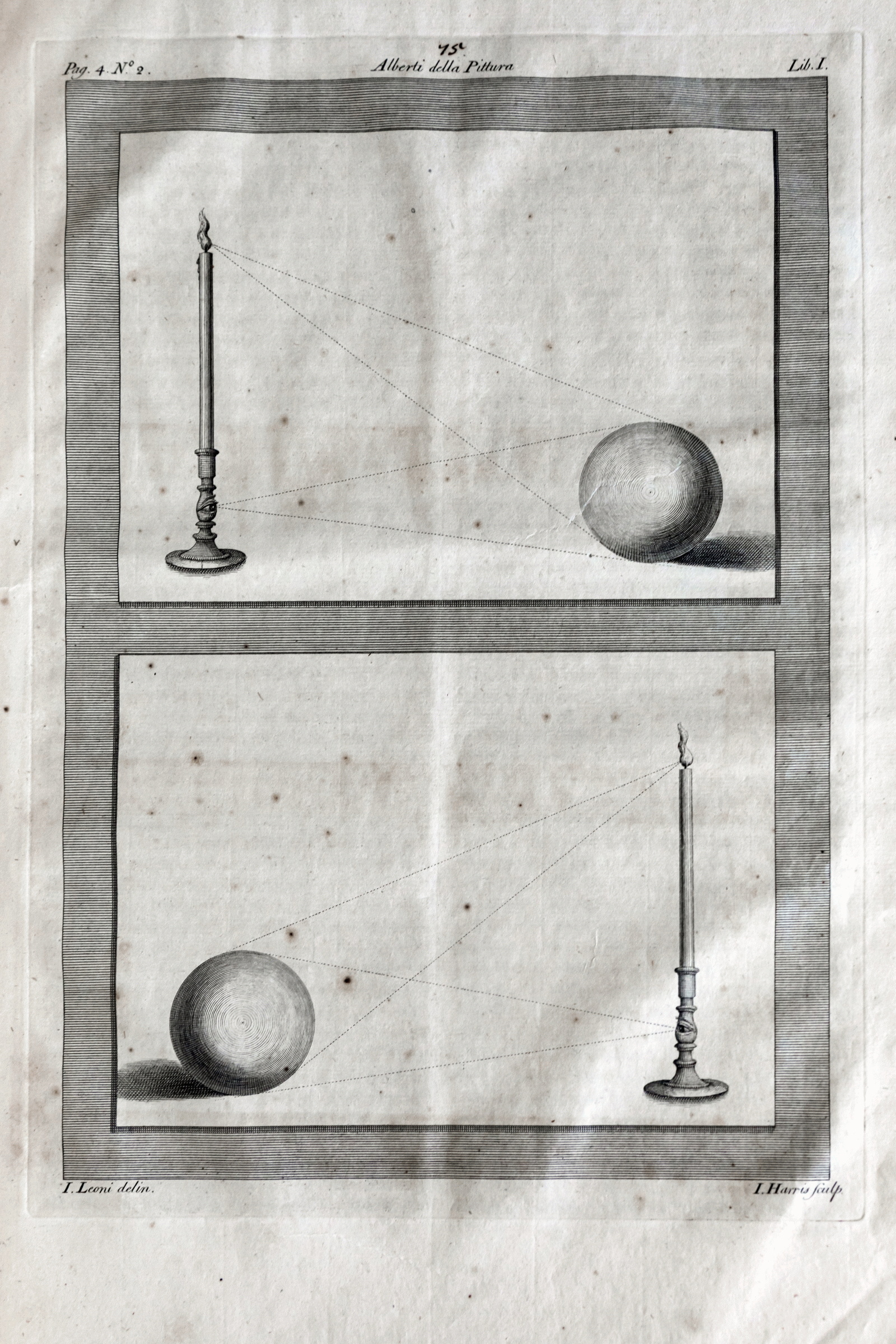
Della Architettura di Leon Battista Alberti Libri X. Della Pittura Libri III. E della Statua Libro I. Tradotti in lingua italiana da Cosimo Bartoli e ristampati da Giacomo Leoni Architetto, London: Thomas Edlin 1726; KHI: H 749s (dimensions: 45,5 x 28,5 x 4 cm).
Della Pittura, engraving no. 15 (I. Harris after Giacomo Leoni) to Libro I.
The rare books section of the library of the Kunsthistorisches Institut in Florence holds seven editions of Leon Battista Alberti’s theoretical treatises on art and architecture, which have not previously been studied in detail. In their multi-layered historical materiality, the often complex word-image relations, as well as their individual edition and reception histories, these exemplars attest to the diverse social contexts, international scholarly circles and political spaces of power – which also include libraries – in which copies of Alberti’s writings circulated. For instance, the compact, typographically simple almost paperback-like format demonstrates how rapidly Alberti’s De pictura had become one of the most frequently consulted ›classics‹ among visual artists. The handwritten annotations by an 18th-century Italian scholar in turn provide contemporary readers with insights into the intense intellectual engagement with Alberti’s theoretical deliberations on architecture and illuminate the process of acquiring and generating knowledge. Last but not least, the translations themselves, as well as the magnificent volumes with their aesthetically and semantically refined illustrations, evince how intensely the reception of Alberti’s treatises was ideologically loaded and shaped on a national level. The collection is therefore a fertile object of research in the fields of visual and cultural studies and demands an interdisciplinary approach. The online exhibition that has sprung from the cooperation between the research project The Edification of the Soul. Leon Battista Alberti’s Dialogue ›On the Tranquility of the Soul‹, based at the KHI since 2018 and the library, is a first step in this direction.
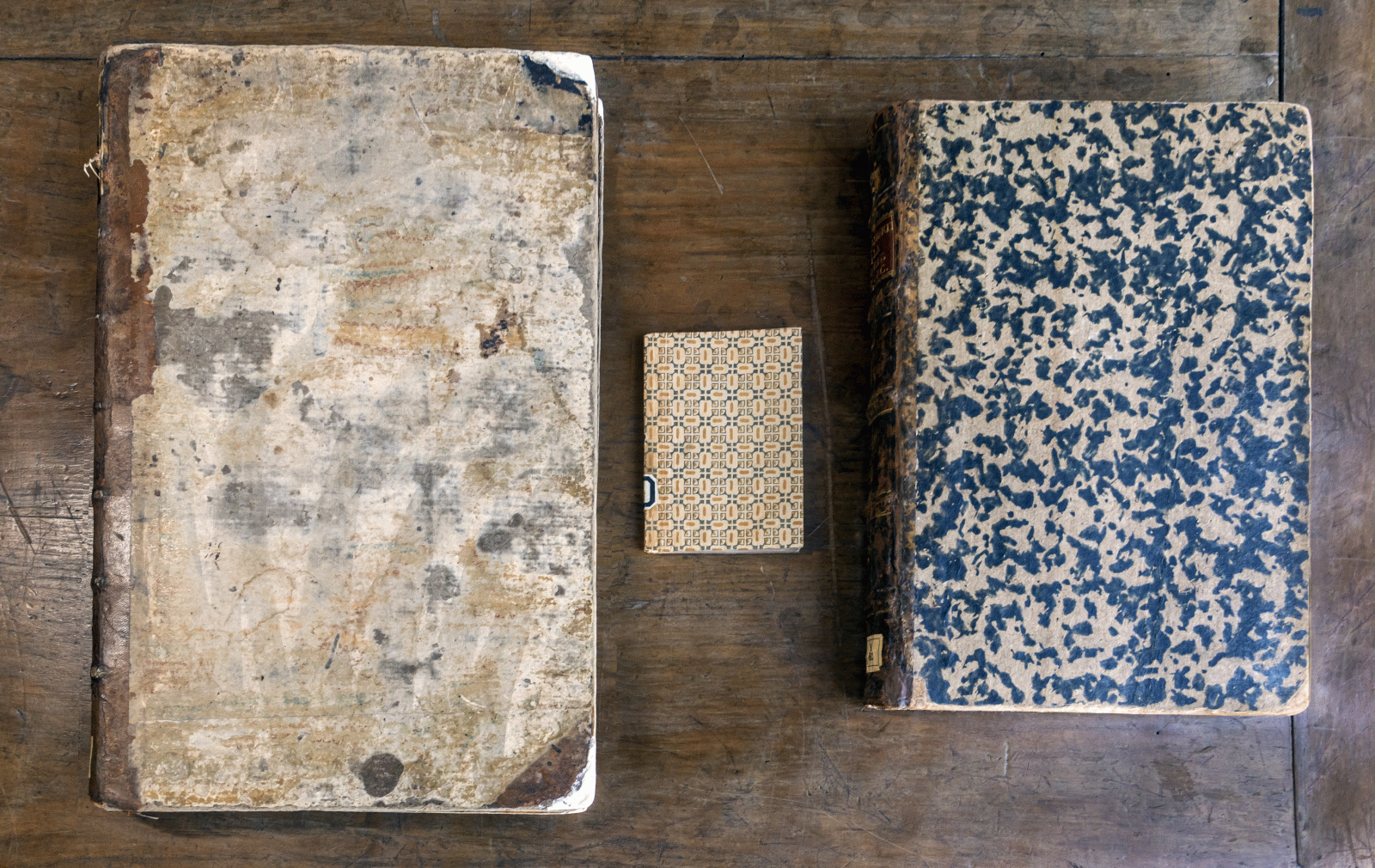
Left: Della Architettura di Leon Battista Alberti Libri X. Della Pittura Libri III. E della Statua Libro I. Tradotti in lingua italiana da Cosimo Bartoli e ristampati da Giacomo Leoni Architetto, London: Thomas Edlin 1726; KHI: H 749s (dimensions: 45,5 x 28,5 x 4 cm).
Centre: La pittura di Leonbattista Alberti tradotta per M. Lodovico Domenichi, Venice: Gabriel Giolito de Ferrari 1547; KHI: H 745 (dimensions: 14 x 10 x 0,5 cm).
Right: Della Architettura, Della Pittura e della Statua di Leonbatista Alberti. Traduzione di Cosimo Bartoli Gentiluomo e Accademico Fiorentino, Bologna: Nell’Instituto delle Scienze 1782; KHI: H 760 (dimensions: 37 x 24,5 x 4 cm).
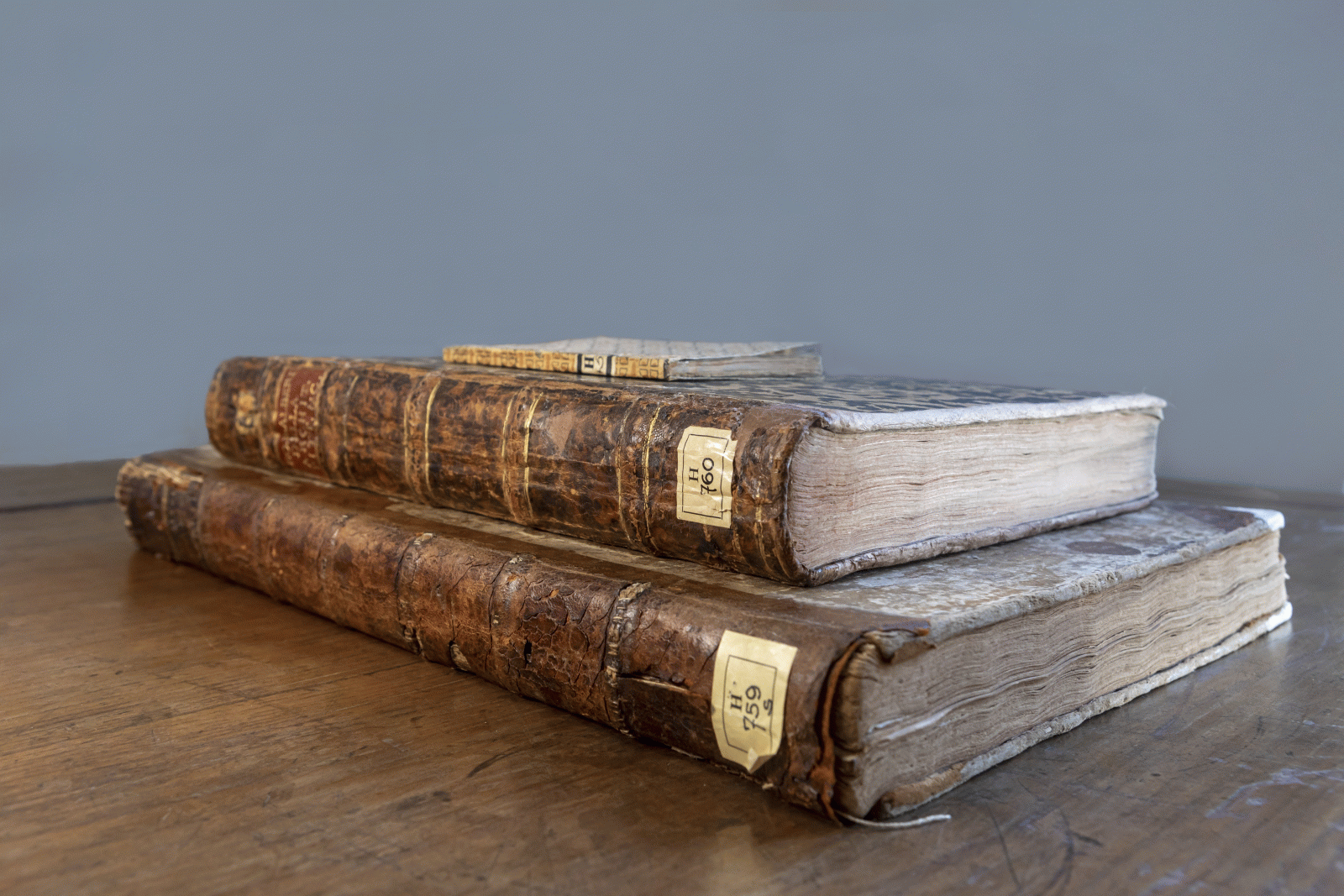
Below: Della Architettura di Leon Battista Alberti Libri X. Della Pittura Libri III. E della Statua Libro I. Tradotti in lingua italiana da Cosimo Bartoli e ristampati da Giacomo Leoni Architetto, London: Thomas Edlin 1726; KHI: H 749s (dimensions: 45,5 x 28,5 x 4 cm).
Centre: Della Architettura, Della Pittura e della Statua di Leonbatista Alberti. Traduzione di Cosimo Bartoli Gentiluomo e Accademico Fiorentino, Bologna: Nell’Instituto delle Scienze 1782; KHI: H 760 (dimensions: 37 x 24,5 x 4 cm).
Above: La pittura di Leonbattista Alberti tradotta per M. Lodovico Domenichi, Venice: Gabriel Giolito de Ferrari 1547; KHI: H 745 (dimensions: 14 x 10 x 0,5 cm).
The various editions of Alberti’s De re aedificatoria, De pictura and De statua were continually modified over the centuries. The materiality of the volumes, their typographical design and layout, but also the overall organisation and arrangement of the writings reveal much about the period-specific reasons for their printing, their particular function for the readership, as well as the context of their handling and use. Since Alberti himself was never able to bring his De re aedificatoria, along with other writings, to print, the design was ultimately left to numerous publishers, printers and printing traditions in different countries and epochs, as the earliest Alberti print in the KHI’s holdings clearly shows.
This 1512 exemplar of De re aedificatoria, printed in Paris by Berthold Rembolt (c. 1460–1518/19) is the earliest book by Leon Battista Alberti in the library’s holdings. In classic octavo format, it represents the first publication of this work to be subdivided into chapters.
The different formats of the volumes are already indicative of their function and intended readership: the small paperback, reduced to text and easily reproducible at a low cost, contrasts with the lavish London edition, which on the one hand has a representative function and on the other provides a broader overview of Alberti’s writings on architecture and painting theory.
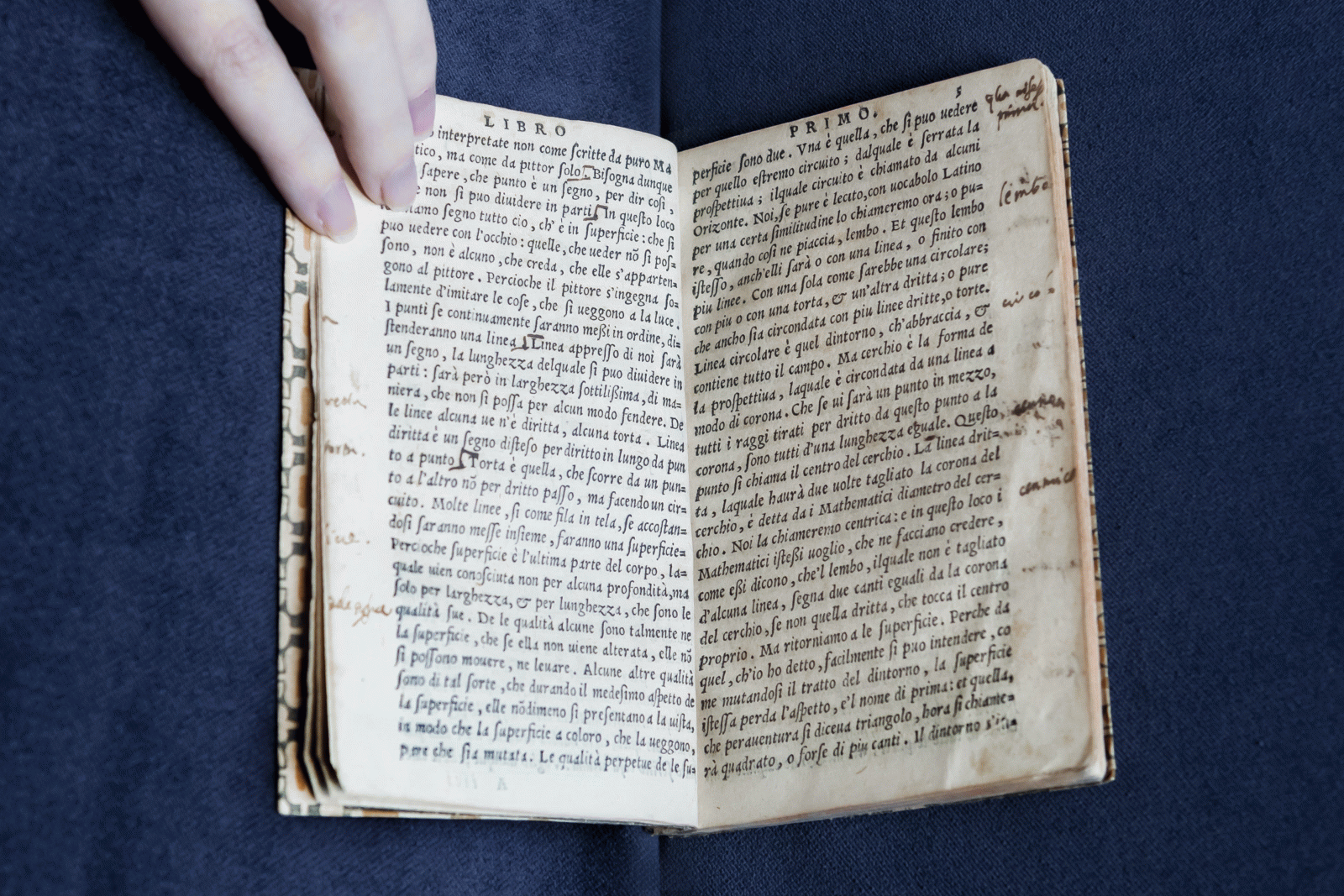
La pittura di Leonbattista Alberti tradotta per M. Lodovico Domenichi, Venice: Gabriel Giolito de Ferrari 1547; KHI: H 745 (dimensions: 14 x 10 x 0,5 cm). P. 4v–5r, book I, double page with annotations in brown ink (undated).
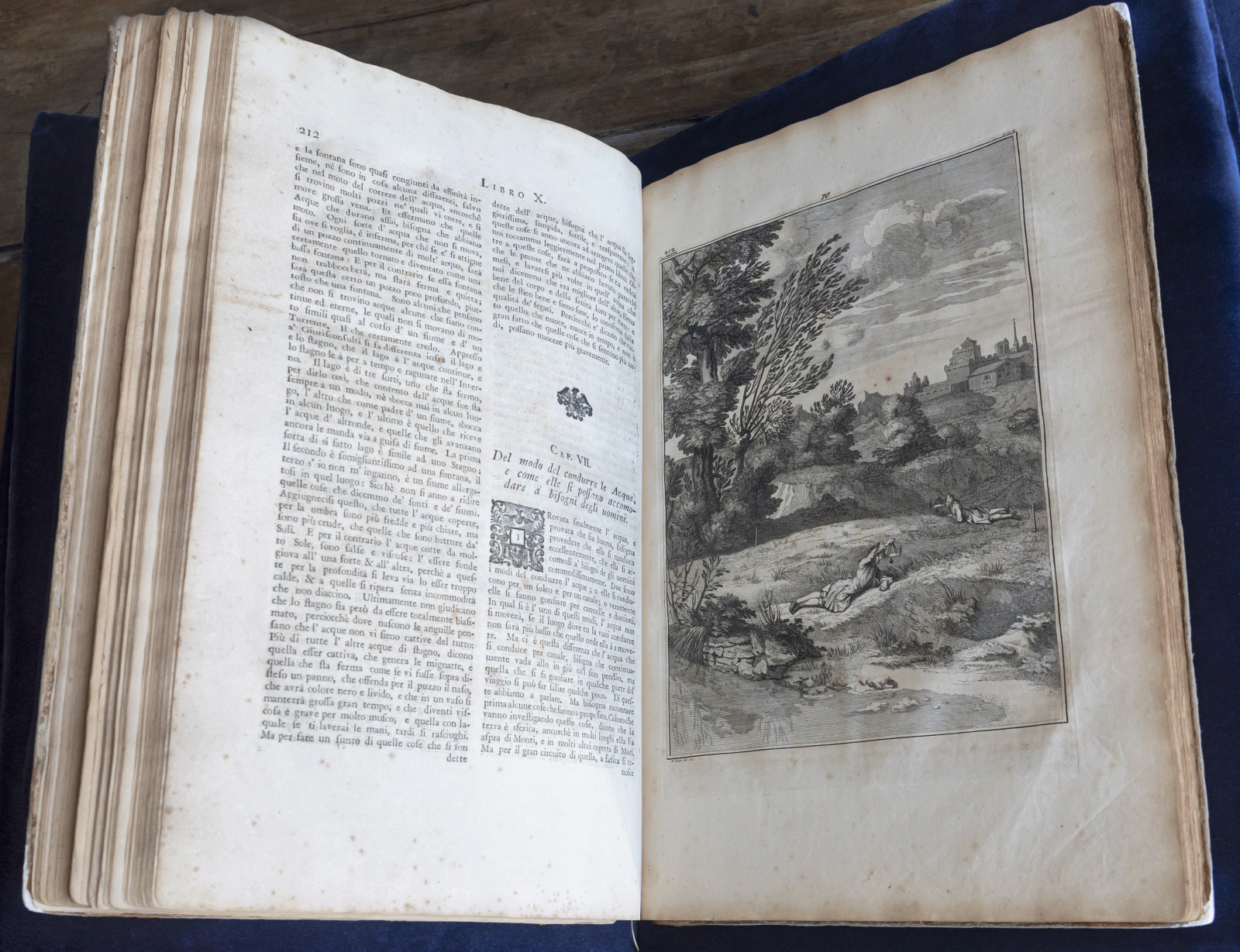
Della Architettura di Leon Battista Alberti Libri X. Della Pittura Libri III. E della Statua Libro I. Tradotti in lingua italiana da Cosimo Bartoli e ristampati da Giacomo Leoni Architetto, London: Thomas Edlin 1726; KHI: H 749s (dimensions: 45,5 x 28,5 x 4 cm).
Della Architettura, P. 212 and engraving no. 70 (Bernard Picart, 1726) to book X, ch. VII: Del modo del condurre le Acque, e come elle si possano accomodare a’ bisogni degli uomini.
The smallest book in the collection, in duodecimal format (14 cm), is a latterly trimmed copy of Lodovico Domenichi’s (1515–1564) vernacular translation of De pictura, printed in Venice in 1547. It appeared seven years after the editio princeps of Alberti’s Latin treatise on painting in Basel in 1540. The ex libris on the front bookplate reveals how it came to the Institute from the estate of the Florence-based German art historian Fritz Gebhard († 1929), who made a generous bequest of books to the library in 1929.
The largest book in the collection, by contrast, is an edition of Cosimo Bartoli’s (1503–1572) translation of De re aedificatoria: printed in London in 1726 by Thomas Edlin (active 1720–1739) and curated by Giacomo Leoni (1686–1746) in large folio format (45.5 cm), the edition features numerous engravings by Bernard Picart (1673–1733). It also contains Alberti’s De pictura and De statua. This valuable and sumptuous copy is dedicated to George I of Hanover (1660–1727), King of Great Britain from 1714. Leoni had already translated Andrea Palladio’s (1508–1580) Quattro libri di architettura into English a few years earlier and subsequently also devoted himself to the translation of Bartoli’s versions of Alberti’s works. The architect Leoni thus provided an important theoretical and practical basis for the neoclassical style of architecture emerging in England at that time, which was particularly popular with the aristocracy for the construction of private palaces.
Domenichi’s translation into vernacular Italian of Alberti’s De pictura, in common with the later translation by Bartoli (1568), demonstrates an attempt at linguistic simplification, the use of modern, contemporary artistic and technical terms, and a toning down of the interweaving with the classical texts, stylistic devices and ideas that were so fundamental to Alberti.
Domenichi, who came from Piacenza, belonged to the court of Cosimo I de’ Medici (1519–1574), so that to some extent Della pittura can be said to be a product of Florentine court-erudition. However, unlike Cosimo Bartoli’s translation of Alberti’s architectural treatise, which appeared three years later, it is addressed to a completely different readership – as is immediately apparent from the handy format and the dedication to an artist.
Domenichi’s dedication to Francesco Salviati (1510–1562) dates from the time of his work on the frescoes in the Sala dell’Udienza in the Palazzo Vecchio (1543–1548), which is explicitly mentioned. The characteristic style of the dedication is also an indication of Salviati’s intense involvement with the scholars of his era and reflects Vasari’s description of the painter as someone who appreciated »to mix with men of learning [...] and he always held plebeian craftsmen in detestation« (Vasari 1914, S. 190).
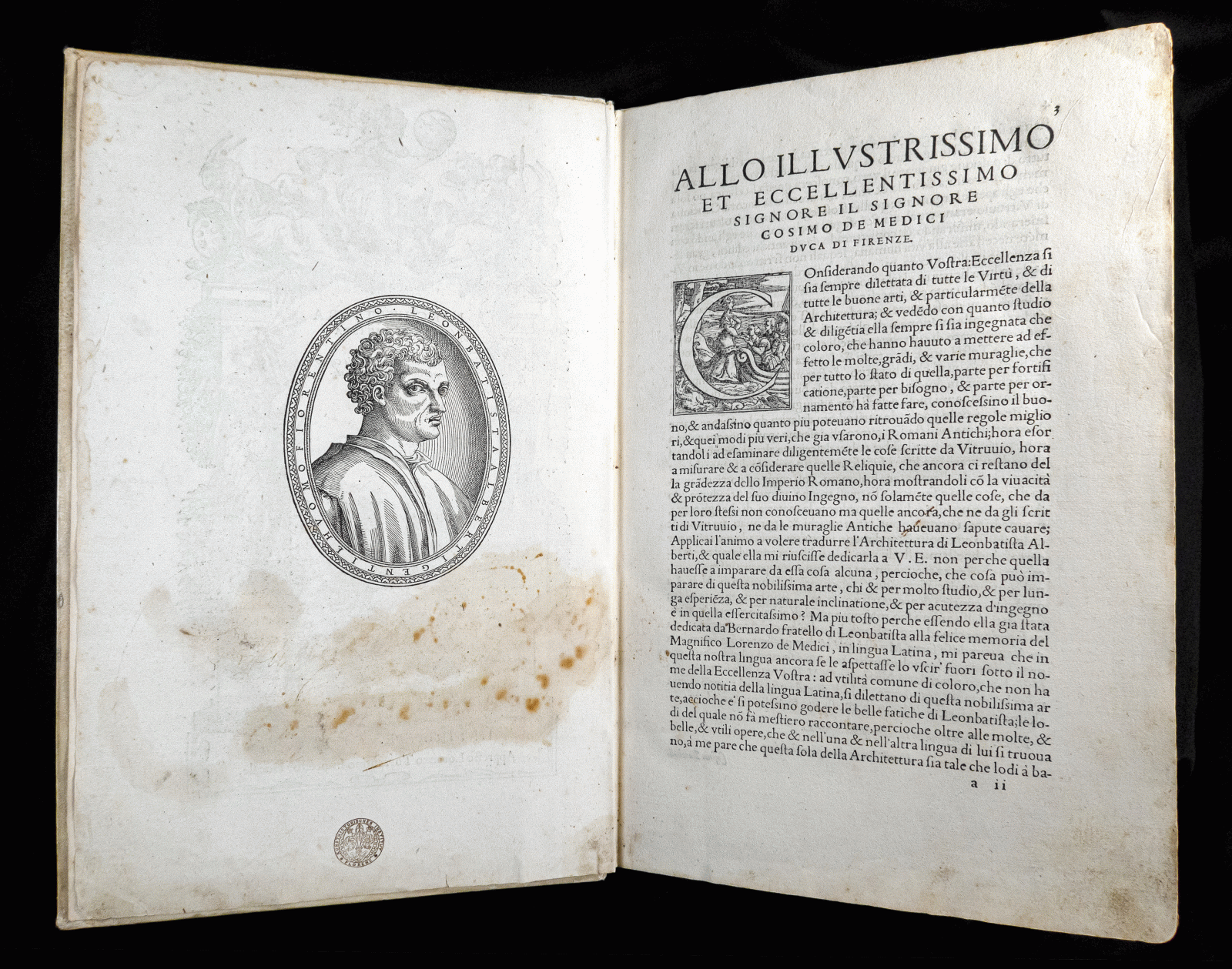
L’Architettura di Leonbatista Alberti. Tradotta in lingua Fiorentina da Cosimo Bartoli Gentil’huomo & Accademico Fiorentino. Con la aggiunta de Disegni, Florence: Lorenzo Torrentino 1550; KHI: H758 (dimensions: 35,5 x 23 x 5 cm).
P. 2–3, portrait of Leon Battista Alberti, woodcut after design by Giorgio Vasari. Dedication »Allo illustrissimo et eccellentissimo signore il signore Cosimo de Medici Dvca di Firenze«.
The first translation into lingua fiorentina of the architectural treatise, undertaken by Cosimo Bartoli, was published in folio in 1550 by Lorenzo Torrentino’s (1499–1563) famous Florentine ducal print shop. The KHI copy is notable for the numerous handwritten annotations by the Sienese humanist Teofilo Gallaccini (1564–1641). Teofilo’s deep interest in architectural theory is evident in the erudite commentaries on the texts he studied as well as in his posthumously published work Sopra gli errori degli architetti (1767), On the errors of architects. Together with four other books annotated by Gallaccini, the copy came to Giuseppe Ciaccheri (1724–1804), who was the first director of the Studio di Siena library from 1759 (cf. the possession note on the frontispiece). From there it went to Florence, where in January 1901 it was acquired along with twenty-three other titles by the Kunsthistorisches Institut at the Seeber/Asta Franchi auction house.
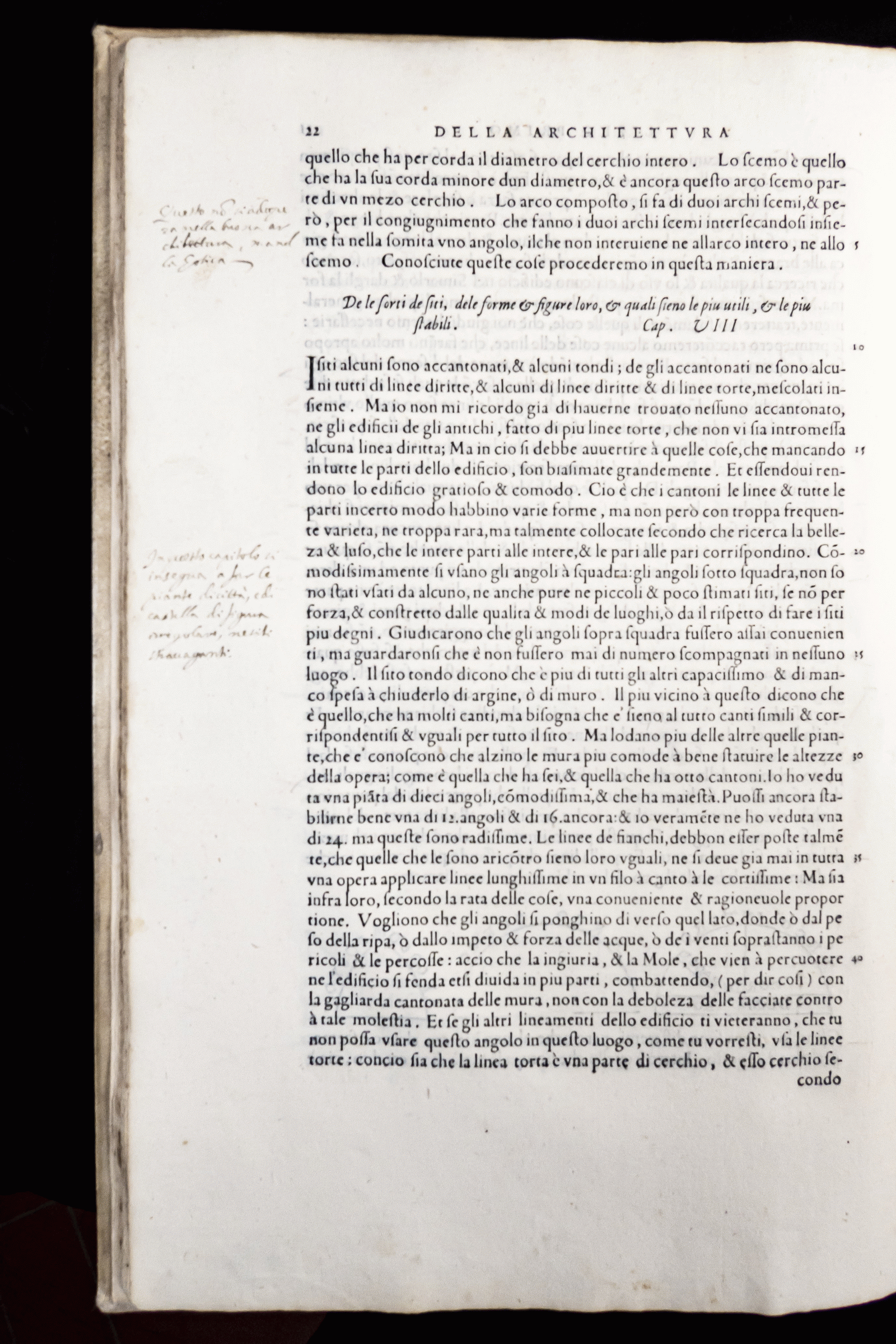
L’Architettura di Leonbatista Alberti. Tradotta in lingua Fiorentina da Cosimo Bartoli Gentil’huomo & Accademico Fiorentino. Con la aggiunta de Disegni, Florence: Lorenzo Torrentino 1550; KHI: H758 (dimensions: 35,5 x 23 x 5 cm).
P. 22, book I, ch. VIII: Delle sorti de siti, de le forme & figure loro, & quali sieno le più utili, & le più stabili. Marginal note by Teofilo Gallaccini (1564–1641). Top left (refers to ch. VII): »Questo non si adopera nella buona architettura, ma nella Gotica«. Centre left: »In questo capitolo si insegna a far le piante di città, e di castella di figura irregolare, ne siti stravaganti«.
Bartoli’s translation of the De re aedificatoria represents a turning point in the history of editions of Alberti’s writings.
The treatise enters Cosimo I de’ Medici’s (cultural) politics via this edition: Bartoli’s programmatic dedication to the duke, which precedes the text, insists, among other things, on the benefit to the community (ad utilità comune) of Alberti’s work, and, thanks to Bartoli’s translation, of Cosimo’s government. The Torrentina edition therefore falls into the period of the canonisation of style and the deliberate ideologisation of bodies of knowledge in the Grand Duchy of Tuscany. The treatise is on the one hand valorised, but on the other appropriated, and in part, expropriated. In fact, the reception of Alberti’s architectural theory up to the time of modern editions and new translations (e.g. into German in 1912 or into Italian in 1966) was strongly influenced by Bartoli’s interpretative reformulation.
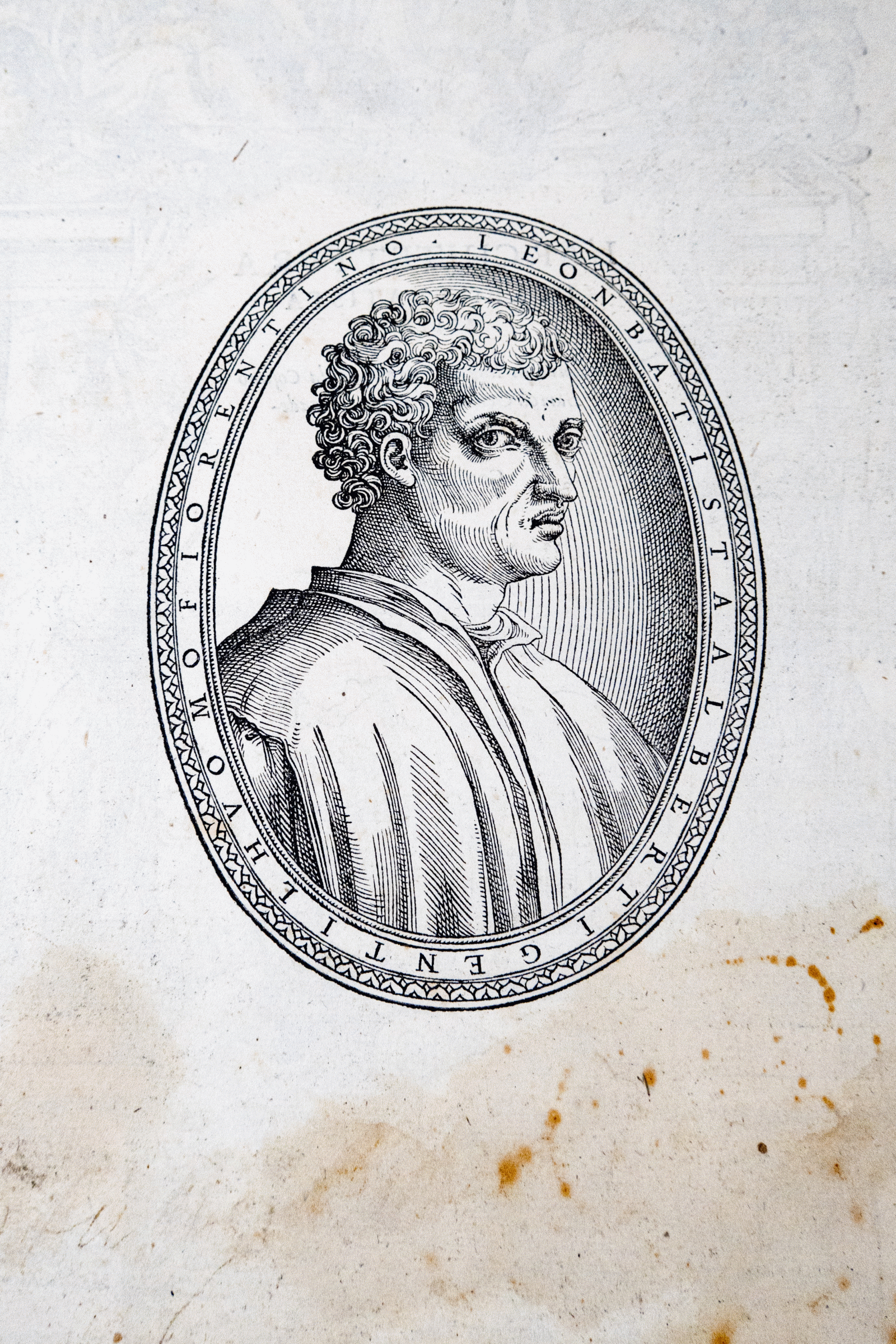
L’Architettura di Leonbatista Alberti. Tradotta in lingua Fiorentina da Cosimo Bartoli Gentil’huomo & Accademico Fiorentino. Con la aggiunta de Disegni, Florence: Lorenzo Torrentino 1550; KHI: H758 (dimensions: 35,5 x 23 x 5 cm).
P. 2, portrait of Leon Battista Alberti, woodcut after design by Giorgio Vasari.
Battista’s lifelong craving to be recognized as a Florentine citizen is here emphasised – in obvious antithesis to the Roman Vitruvius (c. 80 BC – c. 15 AD). The title of the treatise no longer refers to it as the books on building (De re aedificatoria), but simply as Architecture (L’Architettura), after Vitruvius’ classical title. In general, the linguistic influence on the original text is as subtle as it is pervasive, reflecting, among other things, the social-religious climate of the 16th century around the Council of Trent; Alberti’s pluralistic view of religions gives way to a strict and exclusive focus on Christianity.
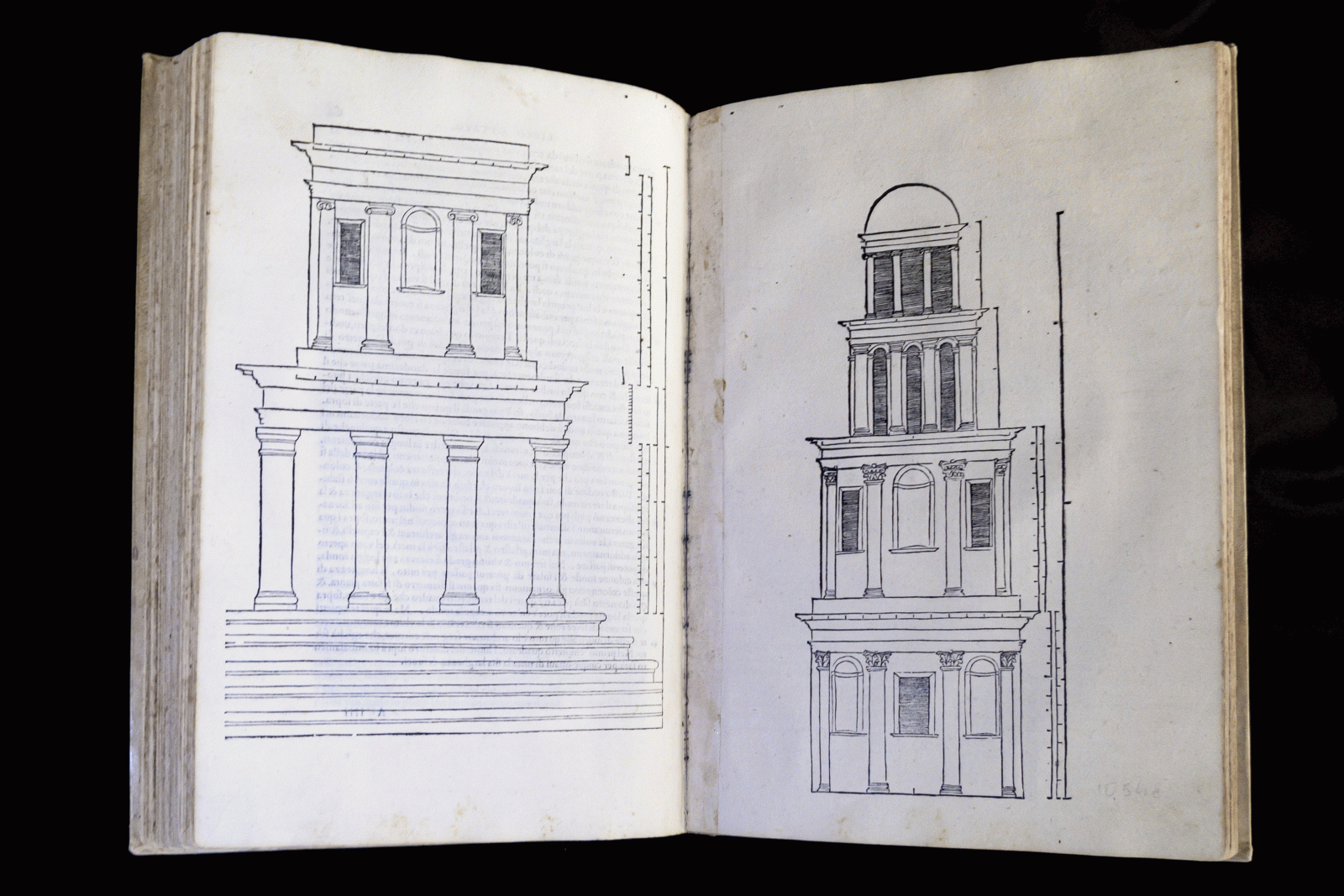
L’Architettura di Leonbatista Alberti. Tradotta in lingua Fiorentina da Cosimo Bartoli Gentil’huomo & Accademico Fiorentino. Con la aggiunta de Disegni, Florence: Lorenzo 1550; KHI: H758 (dimensions: 35,5 x 23 x 5 cm).
Without page reference, two example architectures on book VIII, ch. V (Delle torri, & loro addornamenti).
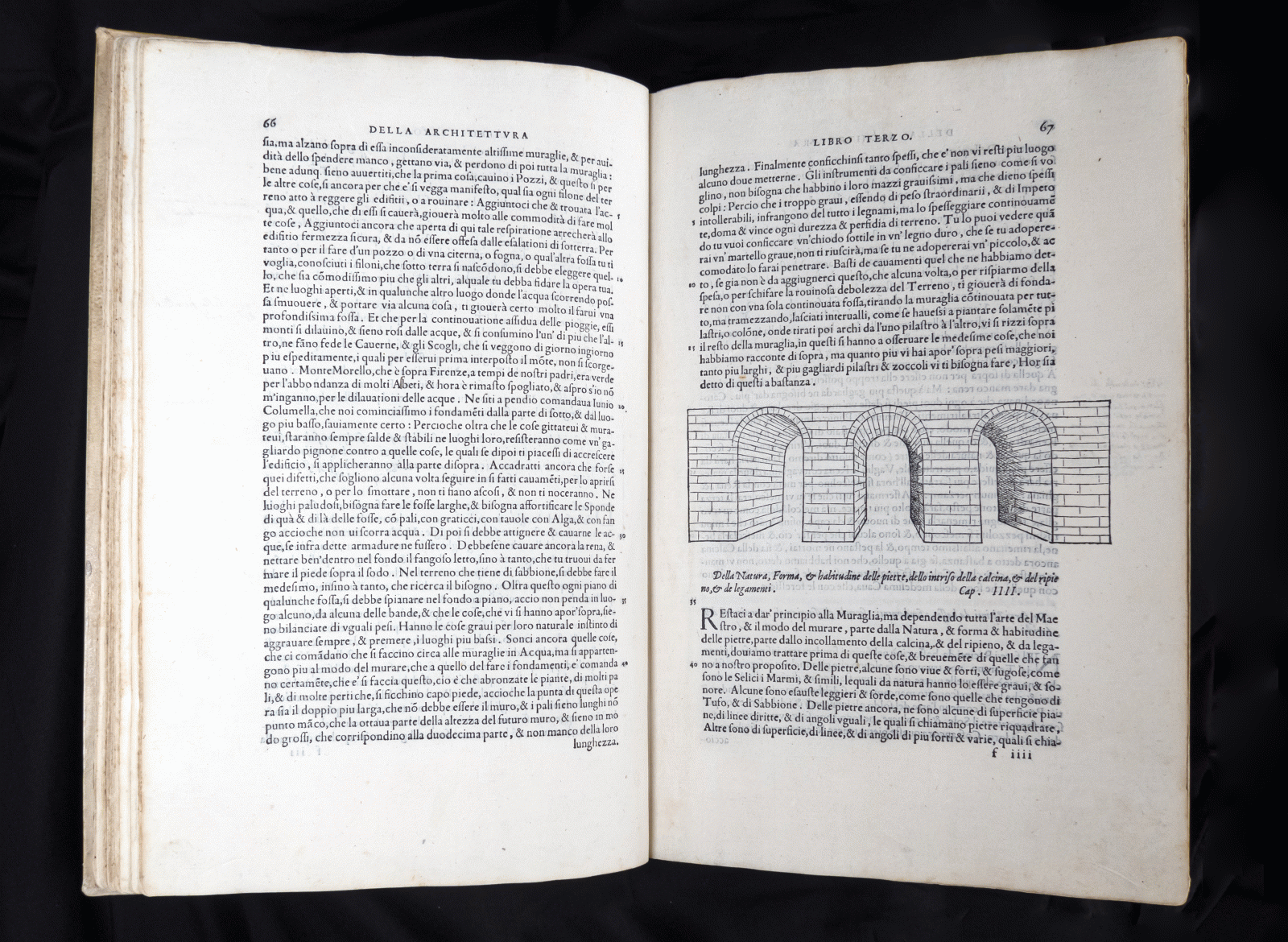
L’Architettura di Leonbatista Alberti. Tradotta in lingua Fiorentina da Cosimo Bartoli Gentil’huomo & Accademico Fiorentino. Con la aggiunta de Disegni, Florence: Lorenzo Torrentino 1550; KHI: H758 (dimensions: 35,5 x 23 x 5 cm).
P. 66–67, book III, ch. III–IIII with woodcut of a three-arched wall as illustration to the following quotation from chapter III: »[…], ti gioverà di fondare non con una sola continuata fossa, tirando la muraglia continuata per tutto, ma tramezzando, lasciati intervalli, come se havessi a piantare solamente pilastri, o colonne, onde tirati poi archi da l’uno pilastro à l’altro, vi si rizzi sopra il resto della muraglia, in questi si hanno a osservare le medesime cose, […]«.
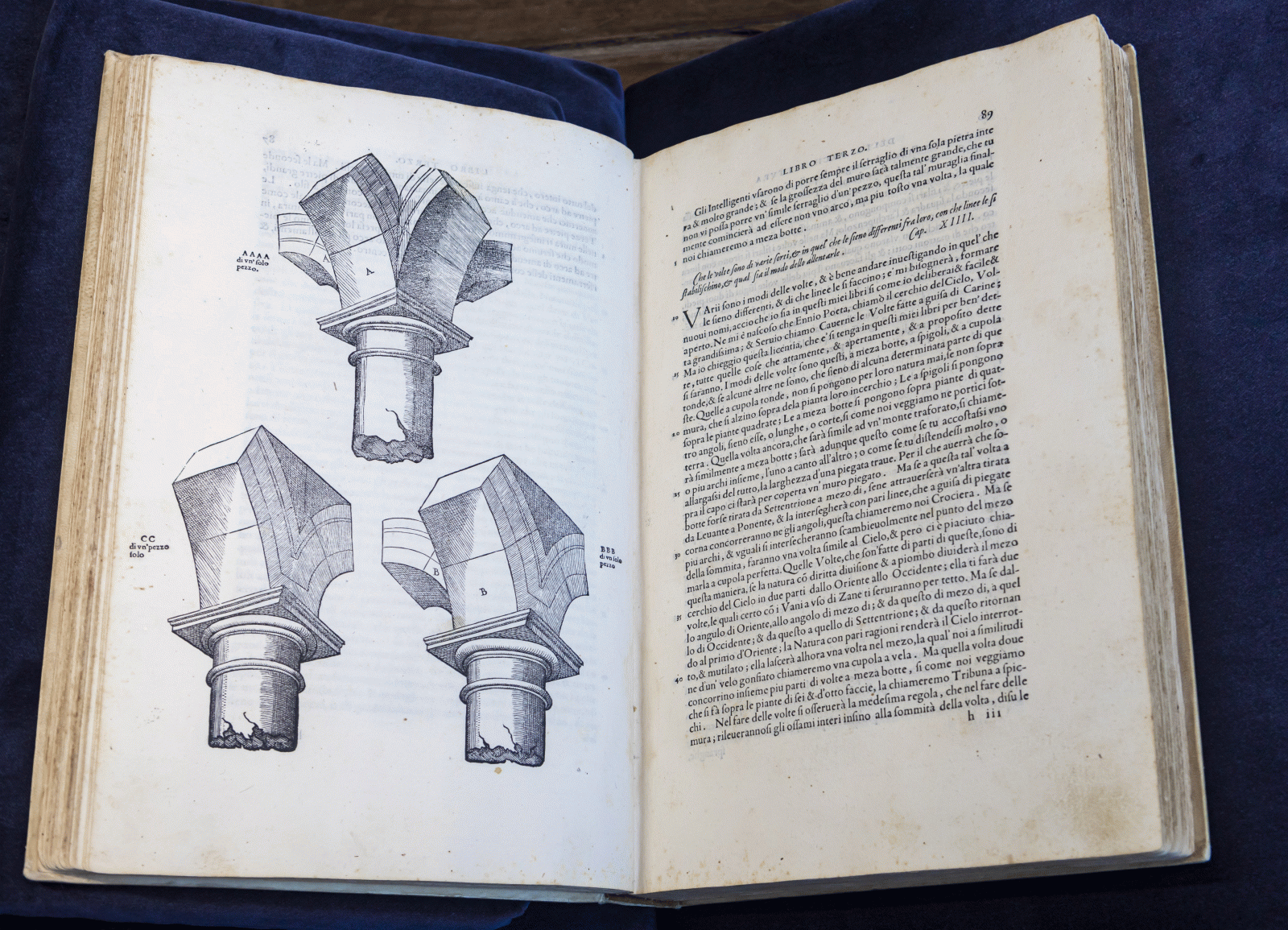
L’Architettura di Leonbatista Alberti. Tradotta in lingua Fiorentina da Cosimo Bartoli Gentil’huomo & Accademico Fiorentino. Con la aggiunta de Disegni, Florence: Lorenzo Torrentino 1550; KHI: H758 (dimensions: 35,5 x 23 x 5 cm).
P. 88–89, book III, ch. XIII: Che le volte sono di varie sorti, & in quel che le sieno differenti fra loro, con che linee le si stabilischino, & qual sia il modo dello allentarle.
The translation made Alberti’s treatise accessible to a much wider readership and goes hand in hand with the images, here included for the first time: more than eighty woodcuts provide instructive explanations of the construction of walls and foundations, illustrate the function of pulleys, and even depict imaginary buildings as examples. Influenced by the pictorial apparatus of certain architectural and mechanical treatises of the preceding decades, the relatively simple woodcuts are an important part of the structuring of the text: while this already adds to the clarity of the text through the clearer separation of the individual chapters and the legibility of the typefaces, it is above all the images that profoundly shape the visual experience as well as the epistemic comprehensibility of the book.
Finally, the utility and impact of these images is demonstrated by the fact that they continue to be used as a visual commentary on Alberti’s text even in modern translations of the Latin De re aedificatoria into Italian (Orlandi/Portoghesi, 1966), English (Rykwert/Tavernor, 1994), and Portuguese (Espirito Santo/Krüger, 2011).
Max Theuer (1878–1949), conversely, created his own drawings for his translation of the Latin De re aedificatoria. A German translation of this edition, the only one of Alberti’s theoretical treatises on architecture to date, is the most recent Alberti print in the KHI’s rare books section.
The Zehn Bücher über die Baukunst (Ten Books on the Art of Building), translated, introduced and illustrated by Max Theuer, was published by Hugo Heller & Co. in Vienna in 1912. Theuer was an architect and professor of architectural history and architectural theory of form at the Technical University in Vienna, and made a significant contribution to the reception of and critical engagement with De re aedificatoria in the twentieth century.
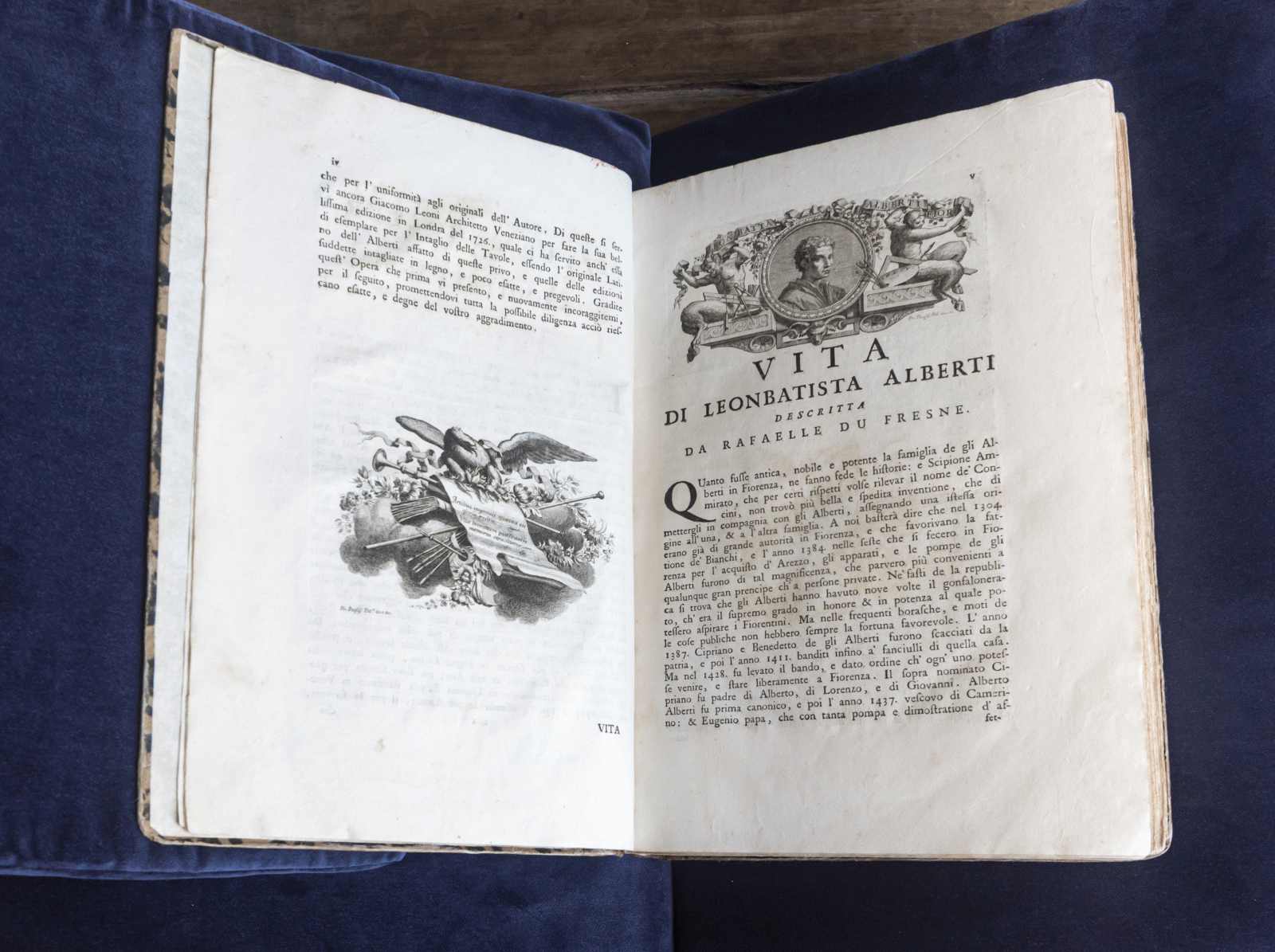
Della Architettura, Della Pittura e della Statua di Leonbatista Alberti. Traduzione di Cosimo Bartoli Gentiluomo e Accademico Fiorentino, Bologna: Nell’Instituto delle Scienze 1782; KHI: H 760 (dimensions: 37 x 24,5 x 4 cm).
P. IV–V, preface by the editor and Leon Battista Alberti's Vita by Raphael Trichet du Fresne.
Reproductions of Picart’s engravings from the opulent London volume, meanwhile, are included in the third Bartoli edition in the KHI library. It was printed in Bologna in 1872. As with the London edition, it is preceded by a brief biography of Alberti, written in 1651 by Raphaël Trichet du Fresne (1611–1661).
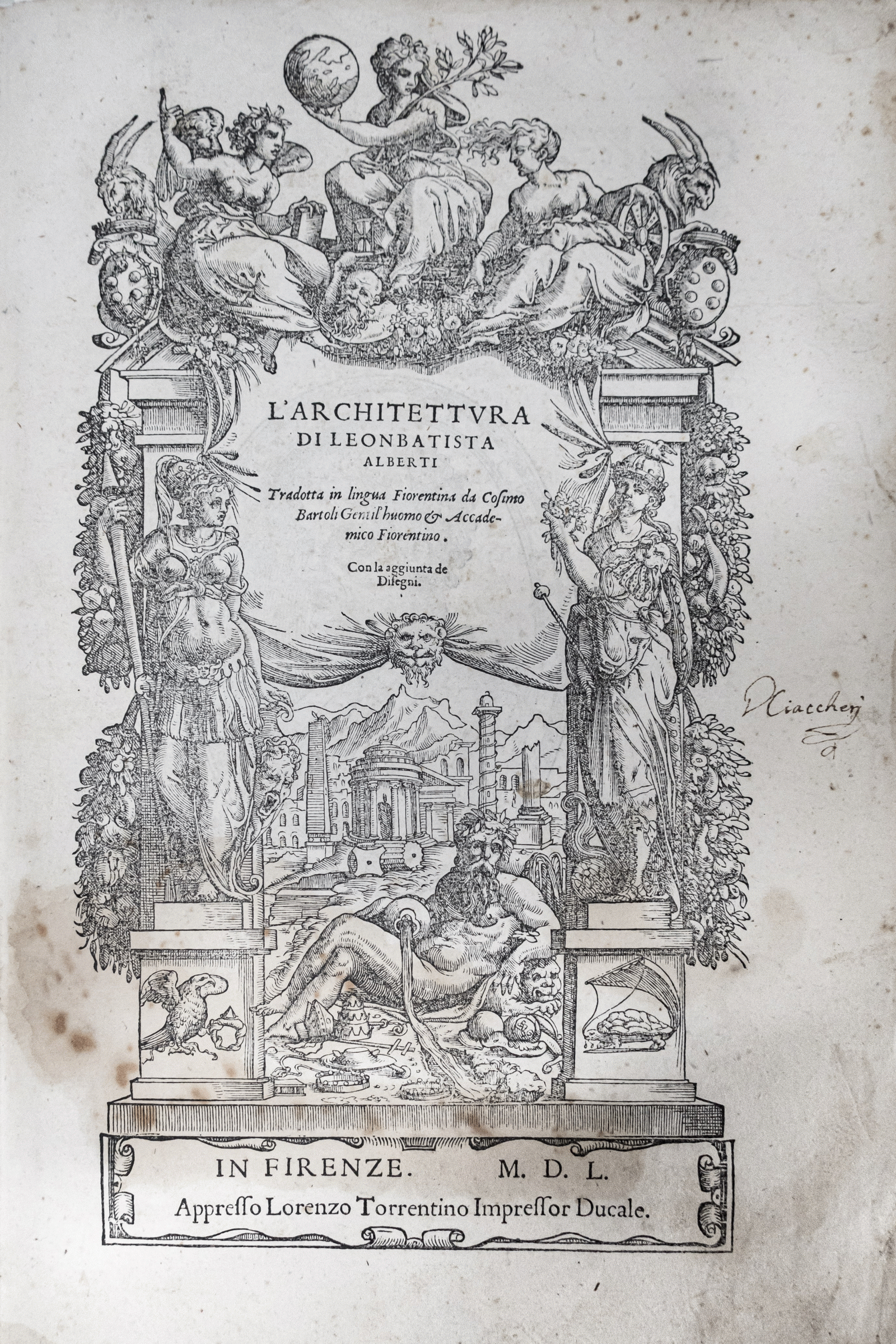
L’Architettura di Leonbatista Alberti. Tradotta in lingua Fiorentina da Cosimo Bartoli Gentil’huomo & Accademico Fiorentino. Con la aggiunta de Disegni, Florence: Lorenzo Torrentino 1550; KHI: H758 (dimensions: 35,5 x 23 x 5 cm).
Frontispiece, woodcut after a design by Giorgio Vasari. On the right margin handwritten ownership note in brown ink: »G. Ciaccheri«.
The prestige value of Bartoli’s 1550 edition is reflected in the elaborately designed title page. Like the portrait of Leon Battista Alberti on the reverse of the page, the frontispiece traces back to drafts by Giorgio Vasari (1511–1574) and is closely connected with the first edition of Vasari’s Vite de’ più eccellenti architetti, pittori, et scultori italiani, which was also produced in Torrentino’s print shop the same year, but in a smaller quarto format.
The symbolically complex composition is probably based largely on a Bartoli idea: the personification of the river Arno is at the lower edge of the picture, while Minerva and Florentia, appearing as cariatydes, frame the title page at the left and right edges. The scene is crowned by a tympanum, where Virtue reposes on the left, Immortality in the centre above Chronos, and lastly Fortuna. The page is bordered with Medici coats of arms, emblems and symbols. The fictitious depiction of Rome in the background elevates Florence as New Rome and reads parallel to the depiction of Florence on the frontispiece to Vasari’s 1550 edition of the Vite.
The frontispiece as an ›entrance portal‹ to Alberti’s architectural treatise emphasised the topicality and political scope of the text, which was almost exactly 100 years old at the time.
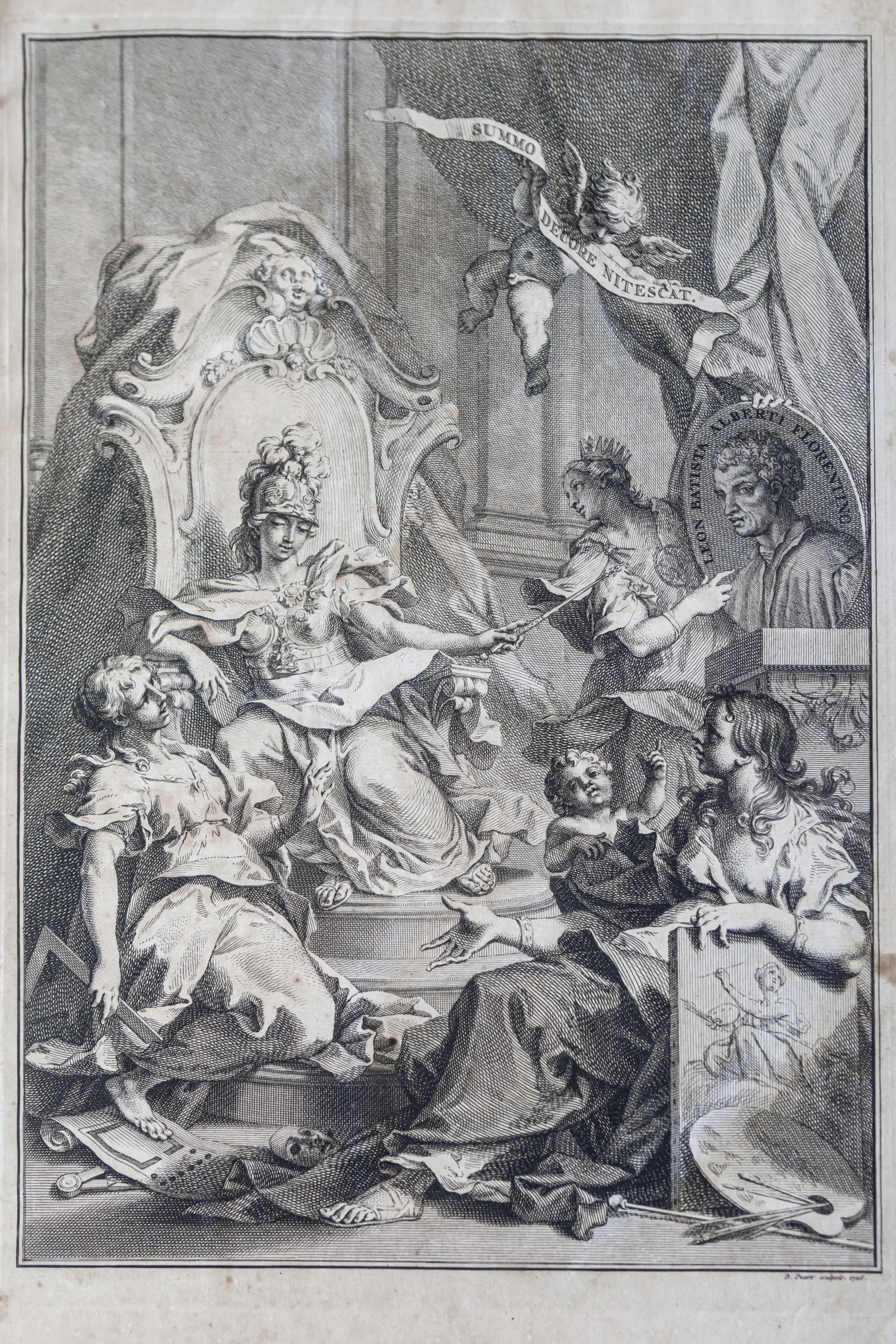
Della Architettura di Leon Battista Alberti Libri X. Della Pittura Libri III. E della Statua Libro I. Tradotti in lingua italiana da Cosimo Bartoli e ristampati da Giacomo Leoni Architetto, London: Thomas Edlin 1726; KHI: H 749s (dimensions: 45,5 x 28,5 x 4 cm).
Frontispiece, engraving by Bernard Picart (1726): Florentia presents Alberti to the enthroned Britannia.
The magnificent editions of the following centuries follow similar strategies. This is also the case in Giacomo Leoni’s edition of Bartoli’s translation, dedicated to George I in 1726, the title page of which is decorated with an equally ingenious and elaborately designed engraving. Here it is the personification of Florentia who offers the portrait of Alberti to the enthroned Britannia, while in the foreground the personifications of Architecture and Painting would appear to be conversing with one another on the merits of Alberti’s work.
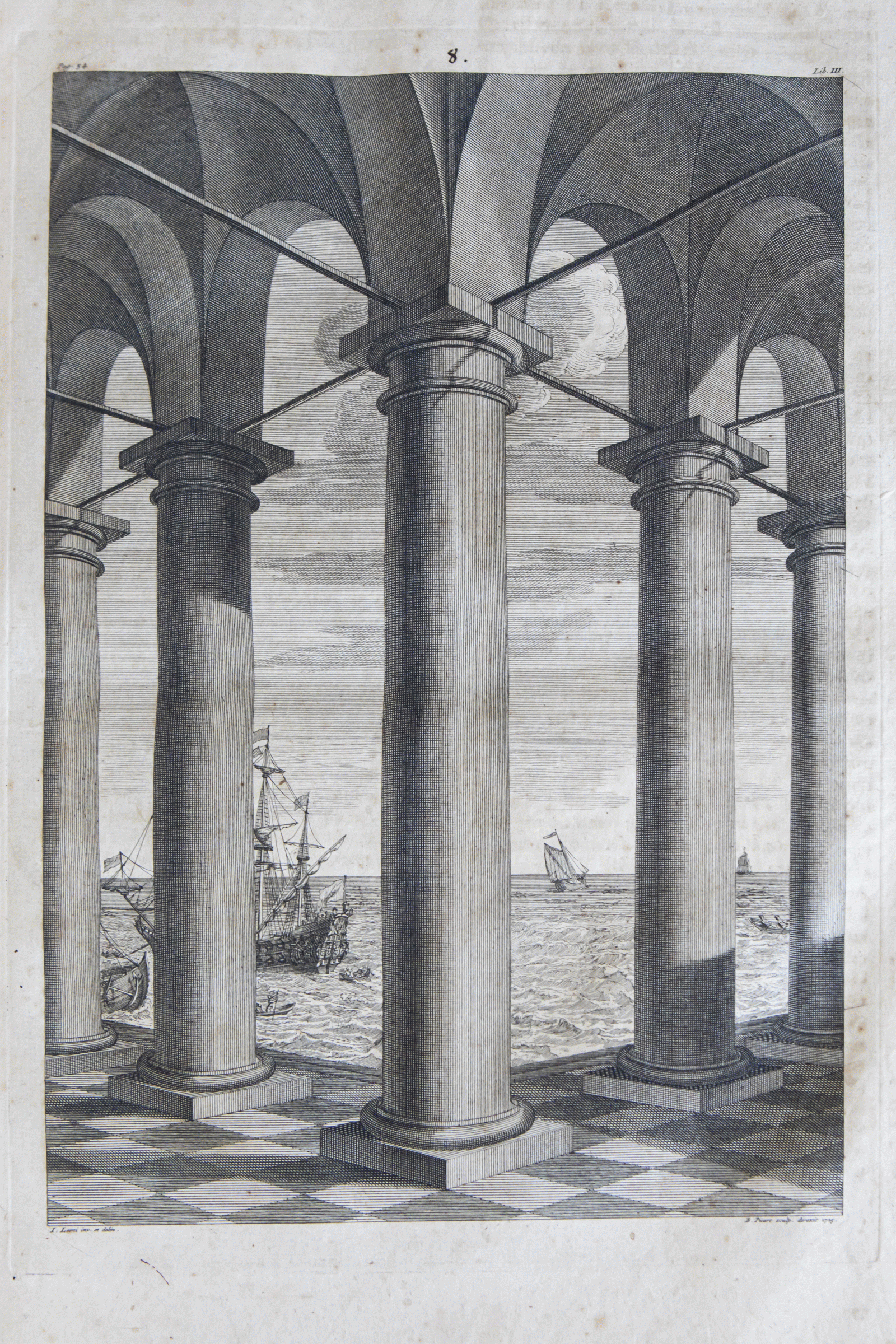
Della Architettura di Leon Battista Alberti Libri X. Della Pittura Libri III. E della Statua Libro I. Tradotti in lingua italiana da Cosimo Bartoli e ristampati da Giacomo Leoni Architetto, London: Thomas Edlin 1726; KHI: H 749s (dimensions: 45,5 x 28,5 x 4 cm).
Della Architettura, engraving no. 8 (Bernard Picart after Giacomo Leoni, 1725) to book III, ch. XIV: Che le Volte sono di varie sorti, e in quel che le siano differenti fra loro, con che linee le si stabiliscano, e qual sia il modo dello allentarle.
This magnificent 1726 volume is notable for its numerous innovative and visually refined engravings. These are in a dynamic dialogue with Alberti’s early modern architectural treatise and, on the one hand, encourage the recipient to scrutinise the pictorial subjects per se, but at the same time sensitise us to the relations between word and image and thus also to consider questions concerning various strategies for conveying knowledge. The four selected engravings show how playfully and skillfully Bernard Picart uses the classical motifs of landscape depictions and harbour vedutas, which were extremely popular in England at the time and widely disseminated through the medium of prints. In this manner Picart forcefully stages the various types of vaults discussed by Alberti and at the same time embeds them in a visual narrative in which the architecturally structured urban space is in dialectical tension with the open horizon of the sea.
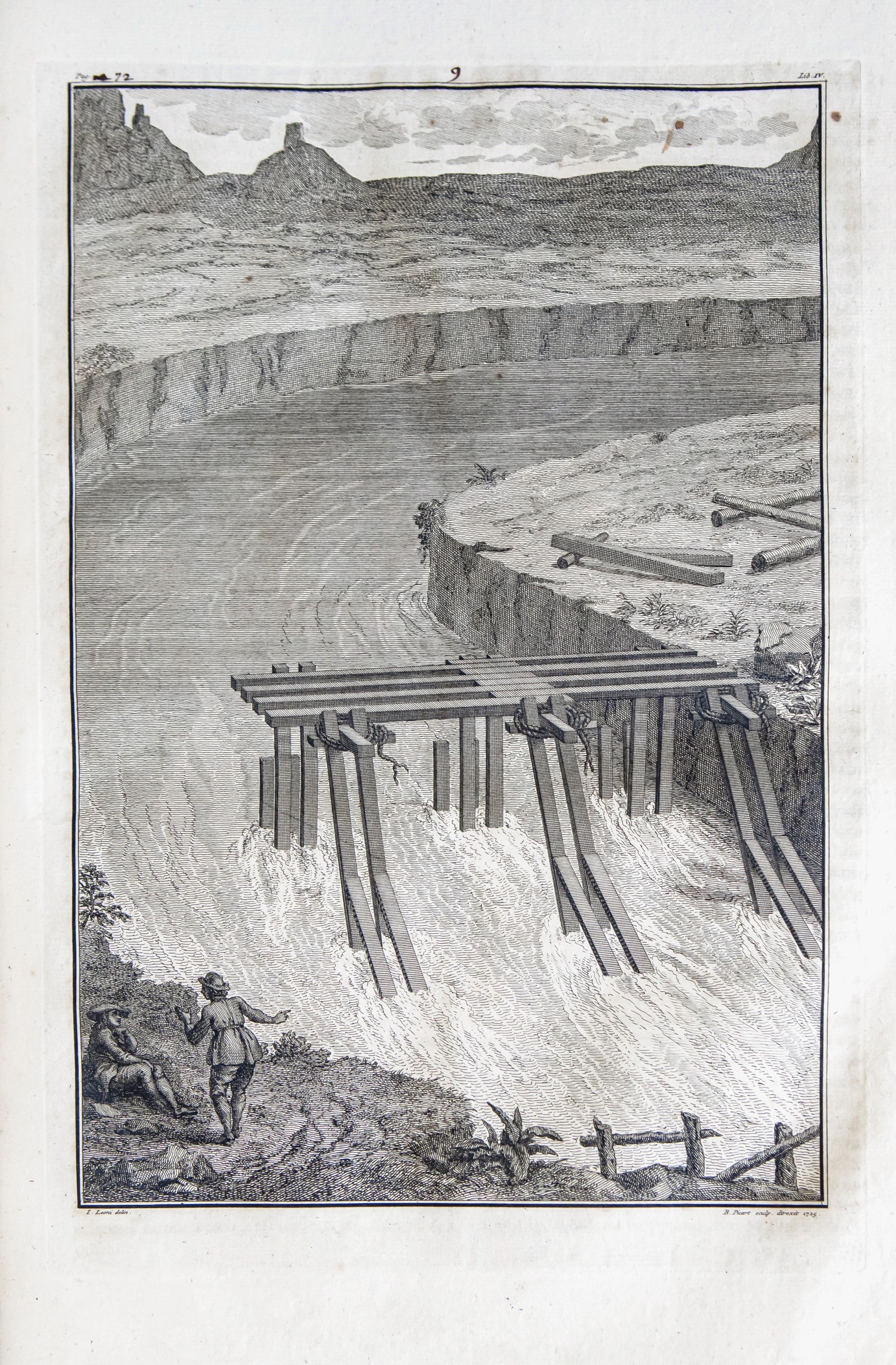
Della Architettura di Leon Battista Alberti Libri X. Della Pittura Libri III. E della Statua Libro I. Tradotti in lingua italiana da Cosimo Bartoli e ristampati da Giacomo Leoni Architetto, London: Thomas Edlin 1726; KHI: H 749s (dimensions: 45,5 x 28,5 x 4 cm).
Della Architettura, engraving no. 9 (Bernard Picart after Giacomo Leoni, 1725) to book IV, ch. VI: De’ Ponti di legno e di pietra, e del Situarli. Delle Pile, Volte, Archi, Cantonate, Ripe, Serragli, Spranghe, Lastricatura, e Rilevo loro.
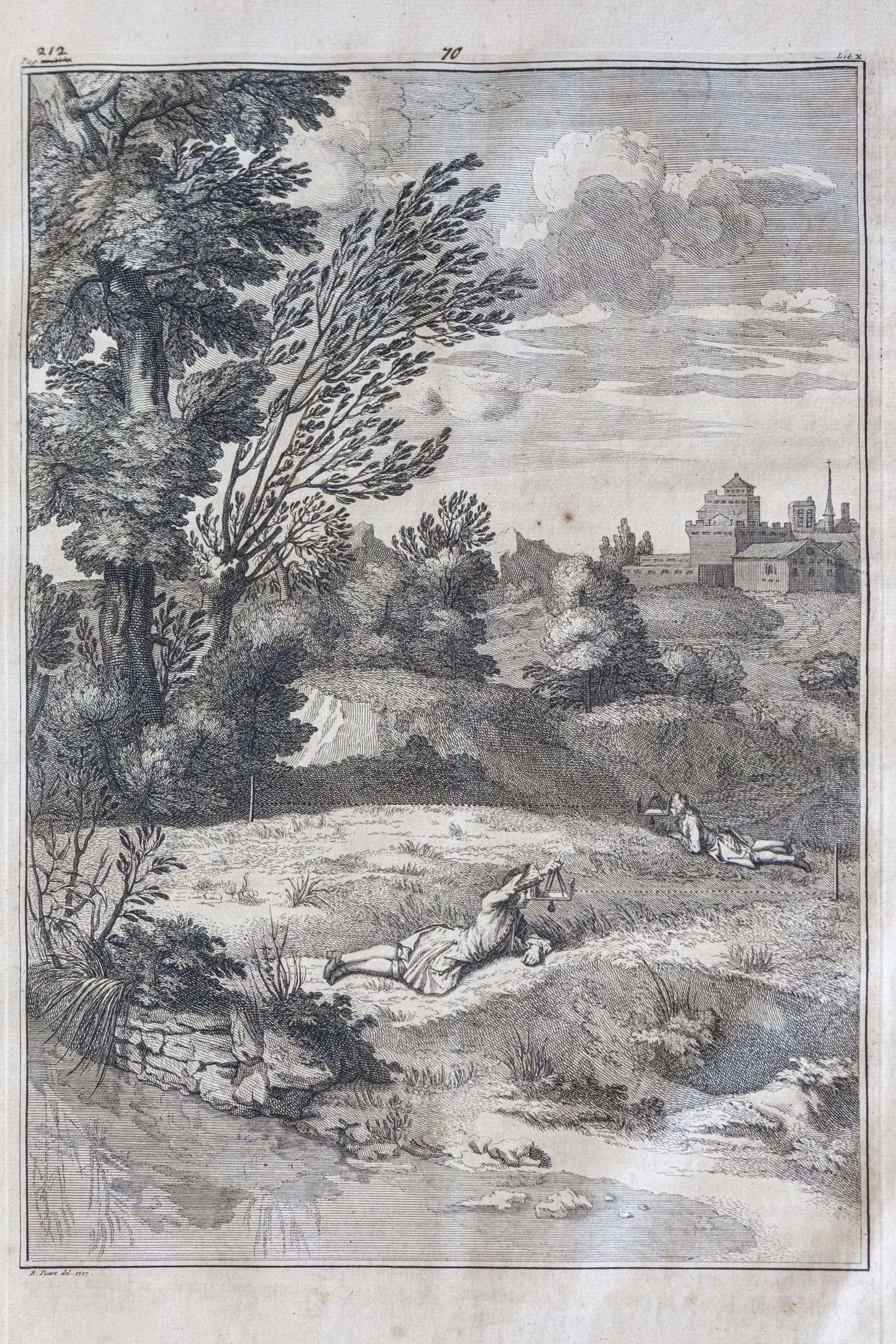
Della Architettura di Leon Battista Alberti Libri X. Della Pittura Libri III. E della Statua Libro I. Tradotti in lingua italiana da Cosimo Bartoli e ristampati da Giacomo Leoni Architetto, London: Thomas Edlin 1726; KHI: H 749s (dimensions: 45,5 x 28,5 x 4 cm).
Della Architettura, engraving no. 70 (Bernard Picart, 1726) to book X, ch. VII: Del modo del condurre le Acque, e come elle si possano accomodare a’ bisogni degli uomini.
In particular, the engravings of Book Ten, in which Alberti reflects on how the unruly element of water can be subjugated for mankind by means of technical-architectural knowledge, are evocative representations of the domestication of nature and the surveying of the world, into which bucolic elements are also integrated through the figures depicted. As with the measuring, disembodied ›Candelabra Eye‹ of the exhibition’s title picture, great importance is attached to the formative power of the perspectival gaze, which orders all before it, objectifies it and steers it along a true course.
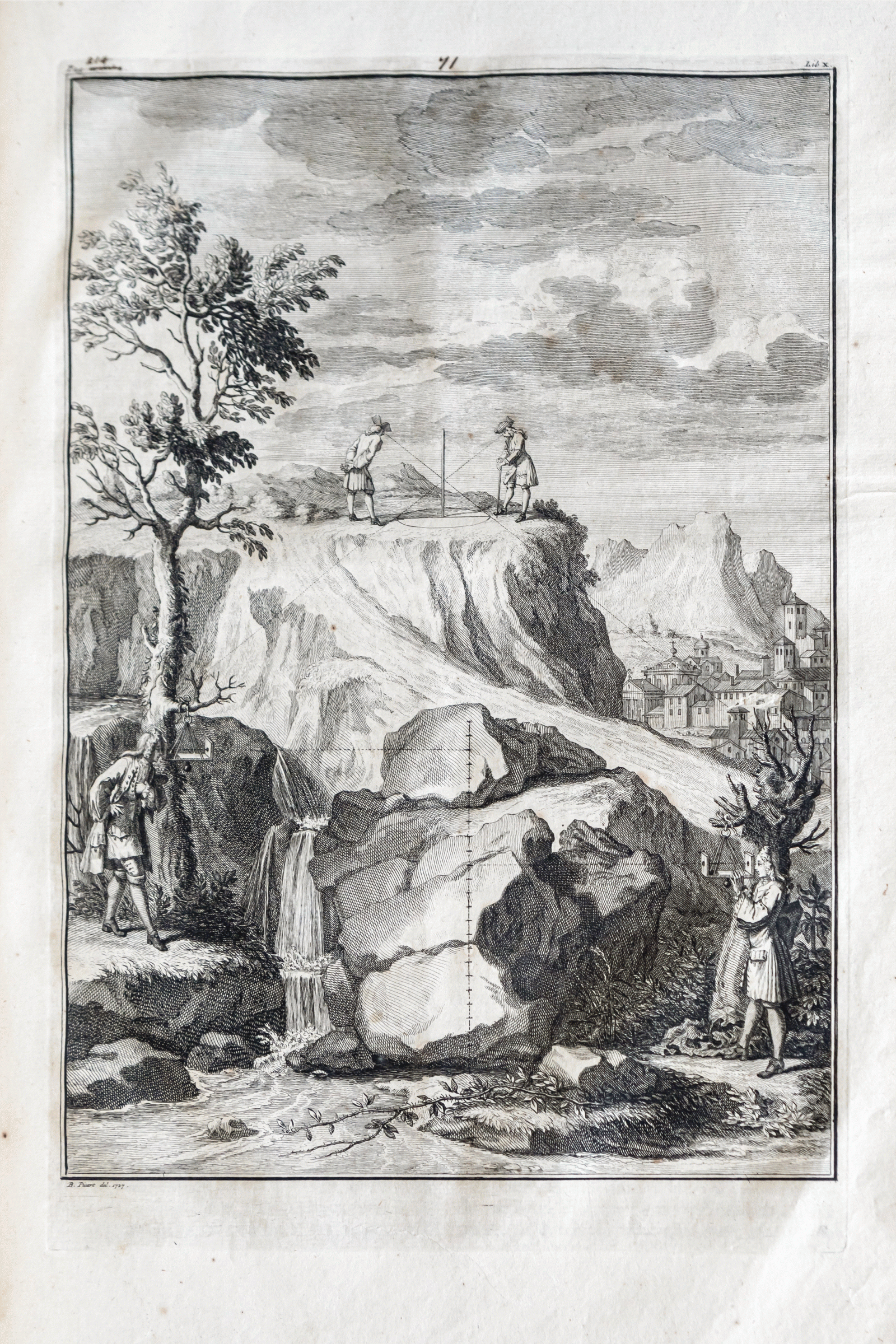
Della Architettura di Leon Battista Alberti Libri X. Della Pittura Libri III. E della Statua Libro I. Tradotti in lingua italiana da Cosimo Bartoli e ristampati da Giacomo Leoni Architetto, London: Thomas Edlin 1726; KHI: H 749s (dimensions: 45,5 x 28,5 x 4 cm).
Della Architettura, engraving no. 71 (Bernard Picart, 1726) to Book X, ch. VII: Del modo del condurre le Acque, e come elle si possano accomodare a’ bisogni degli uomini.
The Latin edition of De pictura of 1540 is also in the library’s holdings, not as an independent edition, rather (along with other works by other authors) bound into a Vitruvius edition of 1649. It was printed in Amsterdam by Louis Elsevier (Lodewijk Elzeverius, 1540–1617) and is dedicated to Queen Christina of Sweden (1626–1689).
The KHI’s rare book collection presented here shows that Alberti’s writings were published early on as part of anthologies and thus received and prepared in interaction with other, thematically similar writings by himself or other authors – whether for the purpose of study or, as the edition dedicated to Christina of Sweden shows, for the overview and prestige presentation of the most important writings by the author, or representative of a specific era. The text of the original manuscript is supplemented, adapted and structured according to the purpose of the respective edition: titles, dedications, prefaces and introductions contextualise the various prints and writings, while further paratextual elements such as frontispieces, lists of contents, footnotes, marginalia and indices, as well as excerpts from Alberti’s biography, his portrait or lists of the most important terms provide additional information and introduce the work. The chapter divisions later introduced in the books of De re aedificatoria, the labelling of important passages in the text by means of small pointing hands (1512, Paris), or the keyword-style summary of a section of the text as marginalia are also instruments of presentation that provide structure and guidance for reception, intended as they are to facilitate easier and more systematic access to the text.
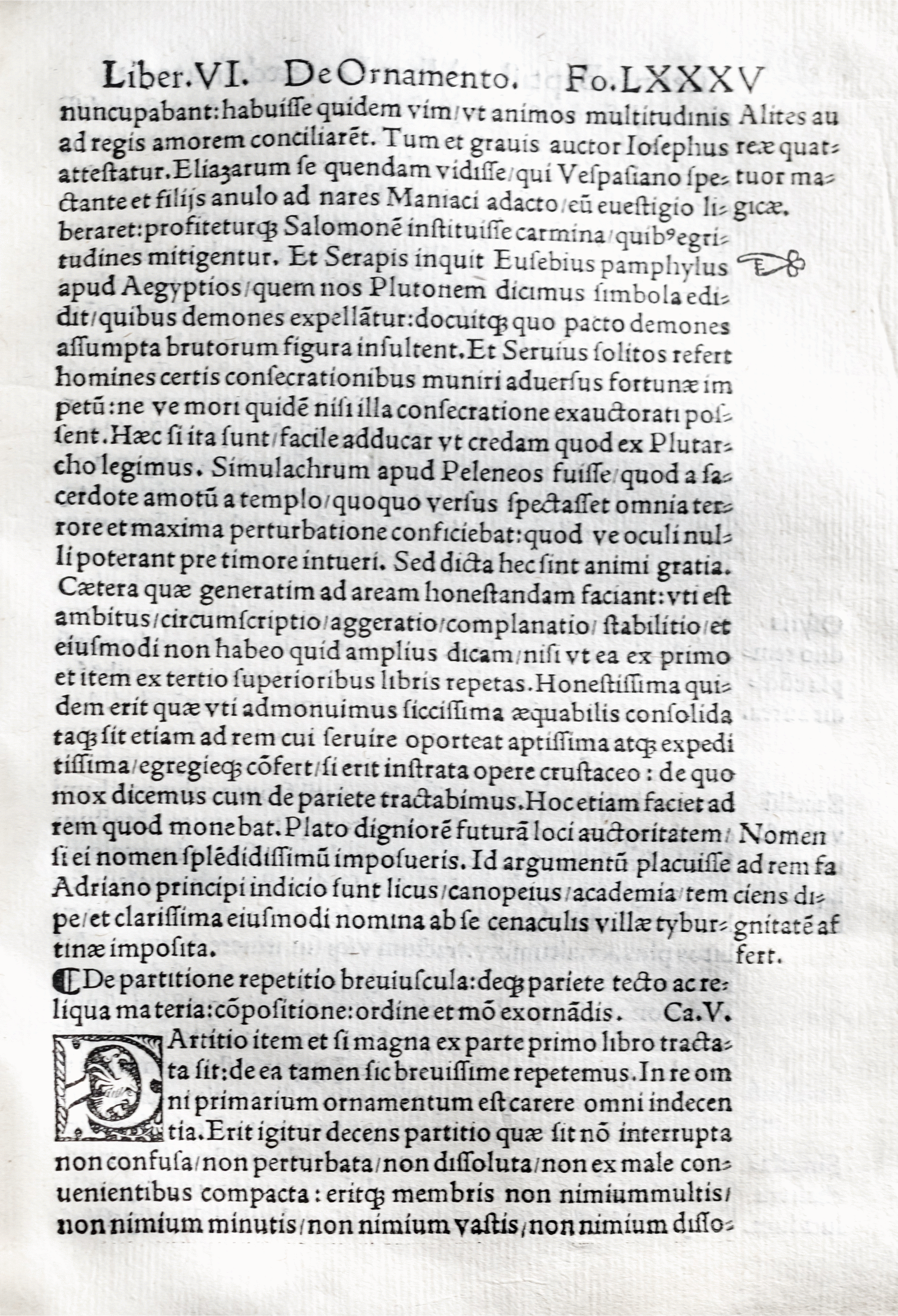
Leonis Baptistae Alberti Florentini viri clarissimi Libri De re aedificatoria decem, Paris: Berthold Rembolt 1512; KHI: H 757 (dimensions: 21 x 15 x 2,5 cm). Folio LXXXV, book VI: De Ornamento, ch. IIII–V.
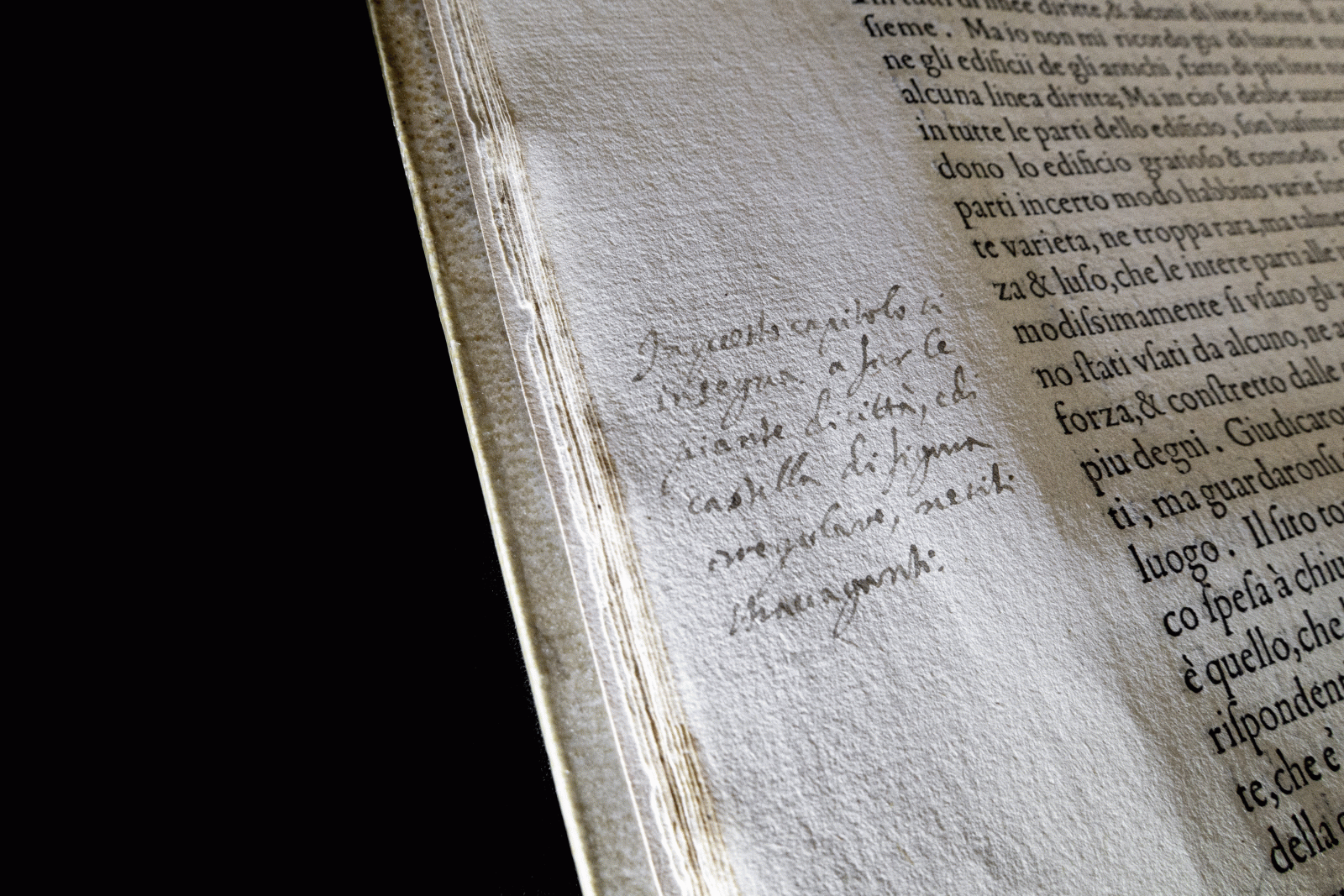
L’Architettura di Leonbatista Alberti. Tradotta in lingua Fiorentina da Cosimo Bartoli Gentil’huomo & Accademico Fiorentino. Con la aggiunta de Disegni, Florence: Lorenzo Torrentino 1550; KHI: H758 (dimensions: 35,5 x 23 x 5 cm).
P. 22, detail of the marginal note: »In questo capitolo si insegna a far le piante di città, e di castella di figura irregolare, ne siti stravaganti«.
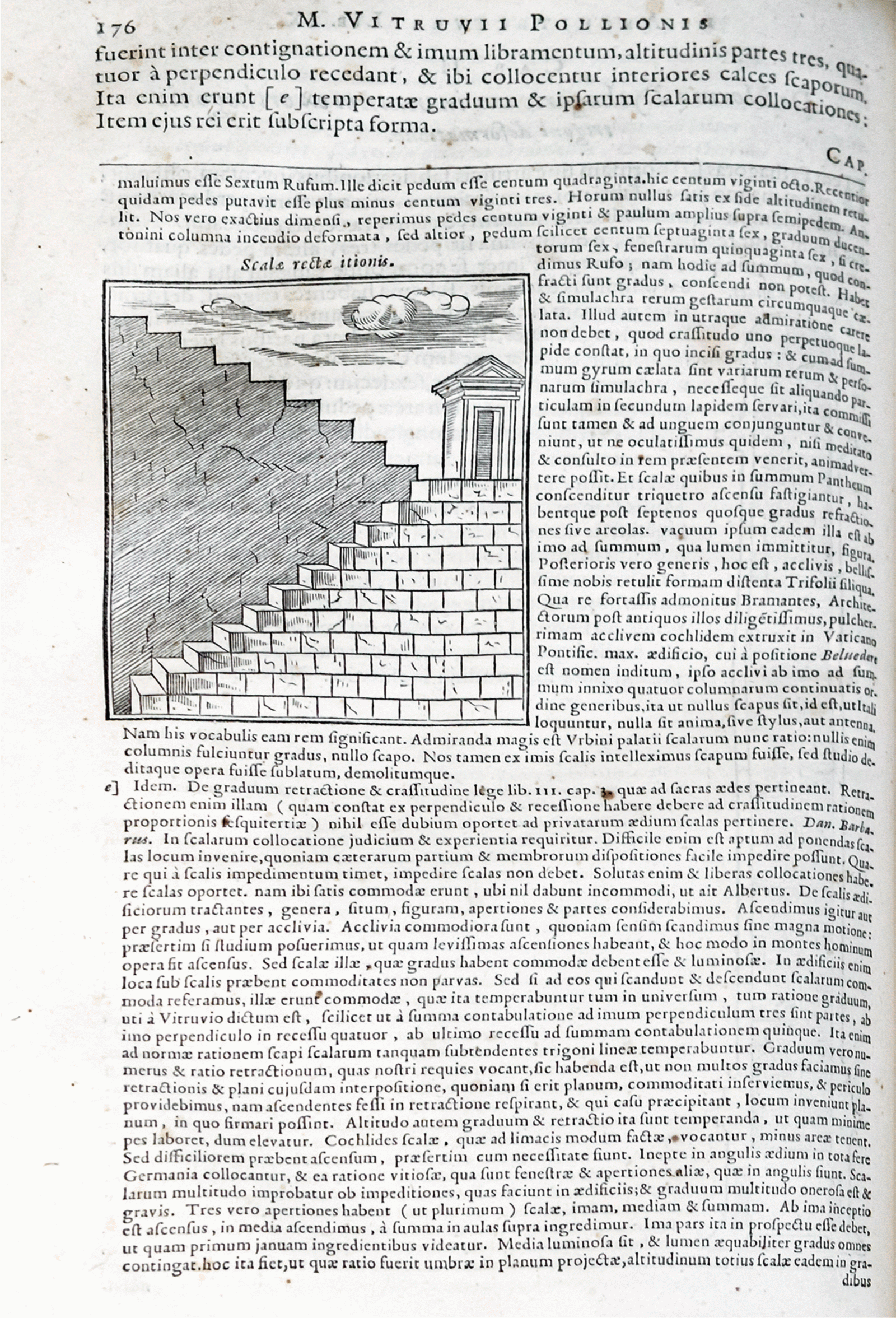
M. Vitruvii Pollionis, De Architectvra Libri Decem, Amsterdam: Louis Elsevier 1649; KHI: D551 (dimensions: 29,5 x 21 x 5 cm). Contains among others: De pictura Libri tres absolutissimi Leonis Bapitistae de Alberti.
P. 176, De Architectura, book IX, ch. II–III. Example of the extensive and elaborately illustrated commentary.
Alberti’s relationship to Vitruvius is known to have been a complex one: on the one hand, he lifted him decisively out of oblivion, productively appropriated his terms and concepts by translating them and, in particular, adopted his division and structuring of the architectural treatise into ten books as well as the idea of designing it as a textbook. On the other hand, in his De re aedificatoria, Alberti also strongly criticises certain principles and views established by Vitruvius. This makes the integration of Alberti’s De pictura (in Latin) as an addition to Vitruvius’ richly illustrated, annotated and footnoted De Architectvra all the more significant. The diagrams integrated into the footnotes, which concretely illustrate the detailed explanations of the linear staircase, are also striking.
Although Alberti also mentions Vitruvius in this text, the structural relationship between the two pieces of writing appears less evident. Through the typographical adoption and embedding of the simply designed Basel print of 1540, which dispenses entirely with an elaborate apparatus of annotation, Alberti’s writing is almost an addendum to Vitruvius’ encyclopaedic work, which in no small measure also thematises the relationship between antiquity and the early Renaissance and at the same time endows it with a certain gravity.
This detail of the frontispiece for the splendid volume dedicated to Christina of Sweden shows the architect and architectural theorist Vitruvius and Emperor Augustus closely examining an architectural drawing. The viewer’s gaze is directed by their hand gestures towards the sketched column. The column motif is deliberately mirrored and visually accentuated by the erection of a free-standing pillar in the background. By staging the erudite dialogue between the ancient ruler and his architect, the frontispiece implicitly pays homage to Queen Christina as a connoisseur of architectural discourse. At the same time, the relevance of architecture for state building is also suggested on a symbolic level: architecture shapes private and social spaces, it orders and structures the coexistence of society, an aspect Alberti emphasises in his De re aedificatoria, even describing the architect as the superior ruler in his satirical writing Momus.
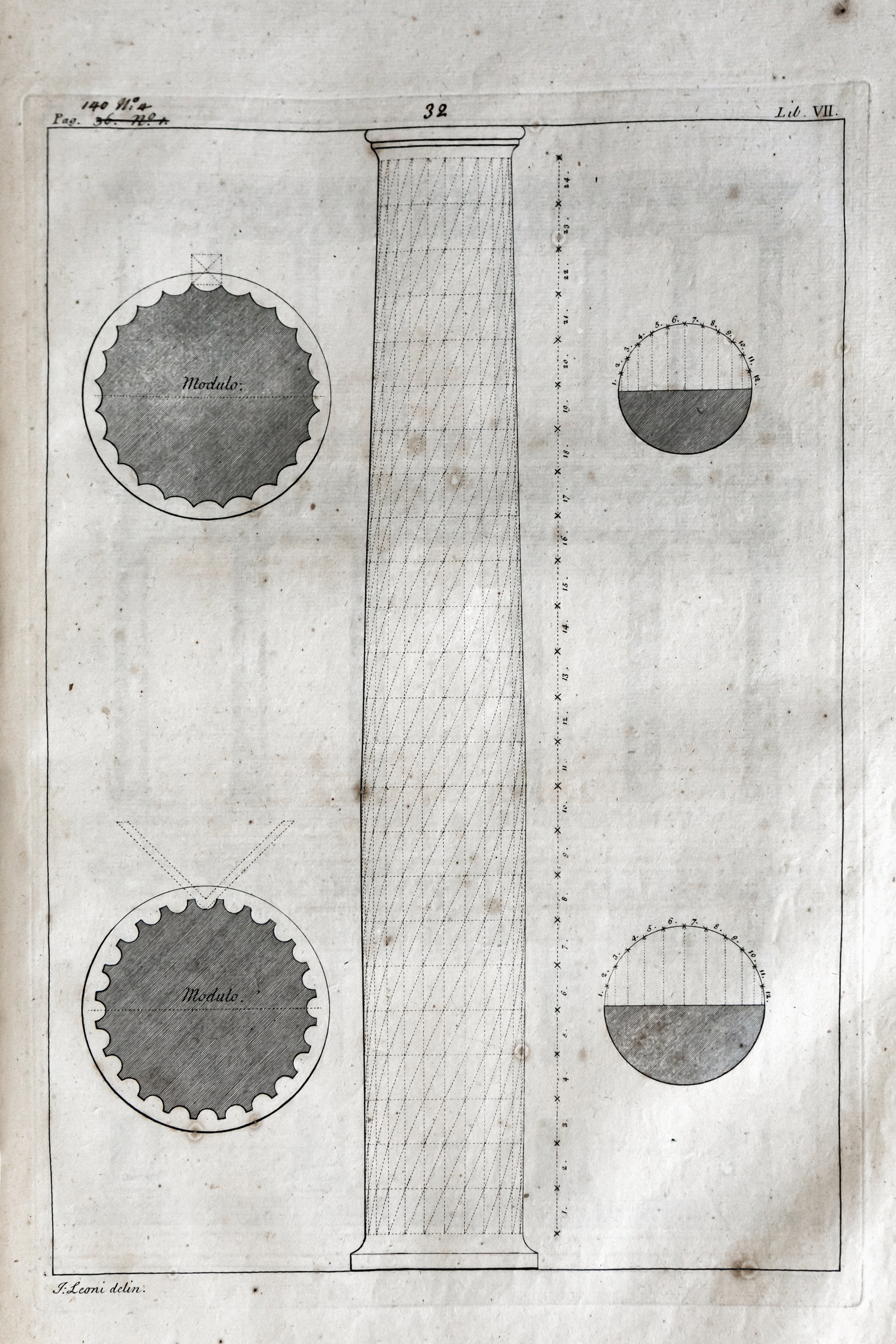
Della Architettura di Leon Battista Alberti Libri X. Della Pittura Libri III. E della Statua Libro I. Tradotti in lingua italiana da Cosimo Bartoli e ristampati da Giacomo Leoni Architetto, London: Thomas Edlin 1726; KHI: H 749s (dimensions: 45,5 x 28,5 x 4 cm).
Della Architettura, engraving no. 32 (after Giacomo Leoni) to book VII, ch. IX: Degli Architravi, Capitelli, de’ Correnti o Fregi, delle Tavole, Mensole o Mensoloni, Regoli, embrici, canali, & altre simili cose appartenenti alle colonne.
The metaphor of the column is important in the literal sense of the word bearing. Alberti himself, significantly, not only addresses columns in his theoretical writings on architecture from a formal, technical or aesthetic perspective, but endows the metaphor of columns with moral-philosophical and social-theoretical purport. In his dialogue Della tranquillità dell’animo (On the Tranquility of the Soul), for example, a classical analogy between column and human being is used to refer to the Stoic bearing of heavy (existential) burdens, against which the individual is better protected through continuous work on oneself. The correlation of architectural structure, moral rectitude and normative order is thus deliberately stressed.
Photographs: Bärbel Reinhard (Fondazione Studio Marangoni)
Concept: Research Group Ethico-Aesthetics of the Visual and Library
Coordination: Research Group Ethico-Aesthetics of the Visual, Library, Research Coordination and Public Relations
Texts: Giulia Baldelli, Hana Gründler, Katharine Stahlbuhk, Katharina Weiger



